A THIRST FOR BLOOD




Has our fascination with the supernatural, vampires, and horror, warped our perception of the vampire bat?














Has our fascination with the supernatural, vampires, and horror, warped our perception of the vampire bat?














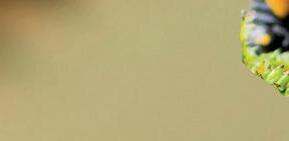








Will we ever get to see thorny devils on this side of the world?




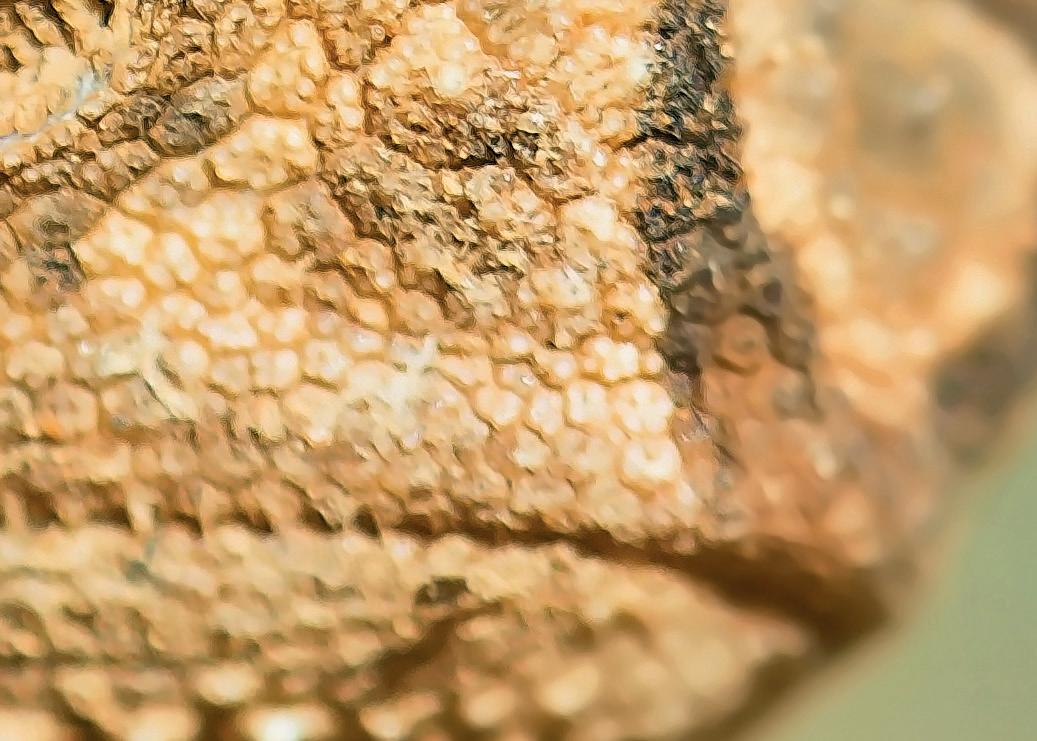
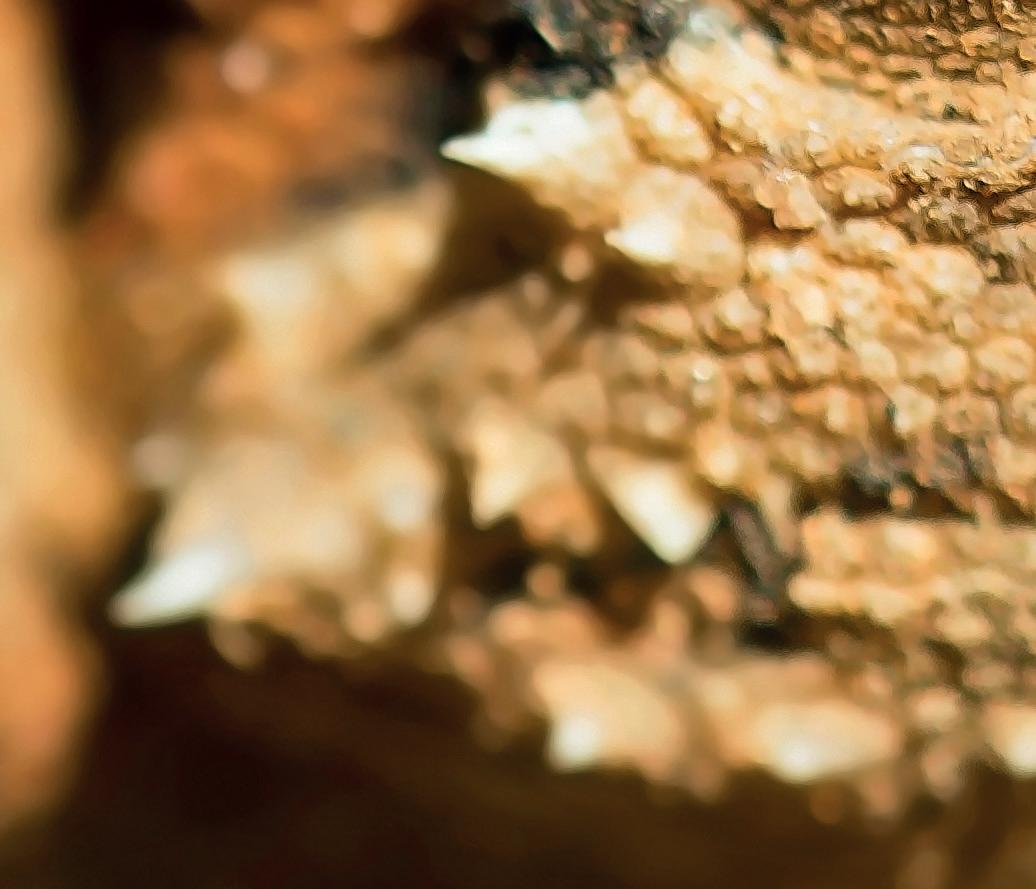
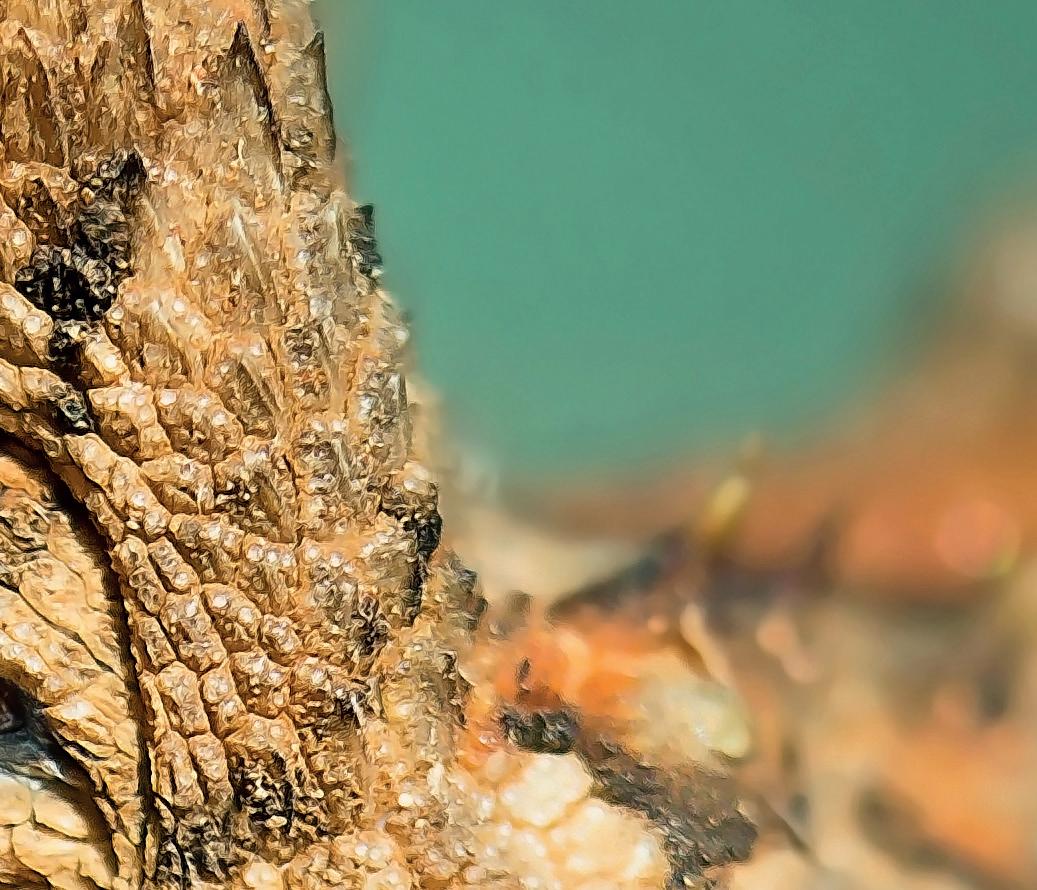
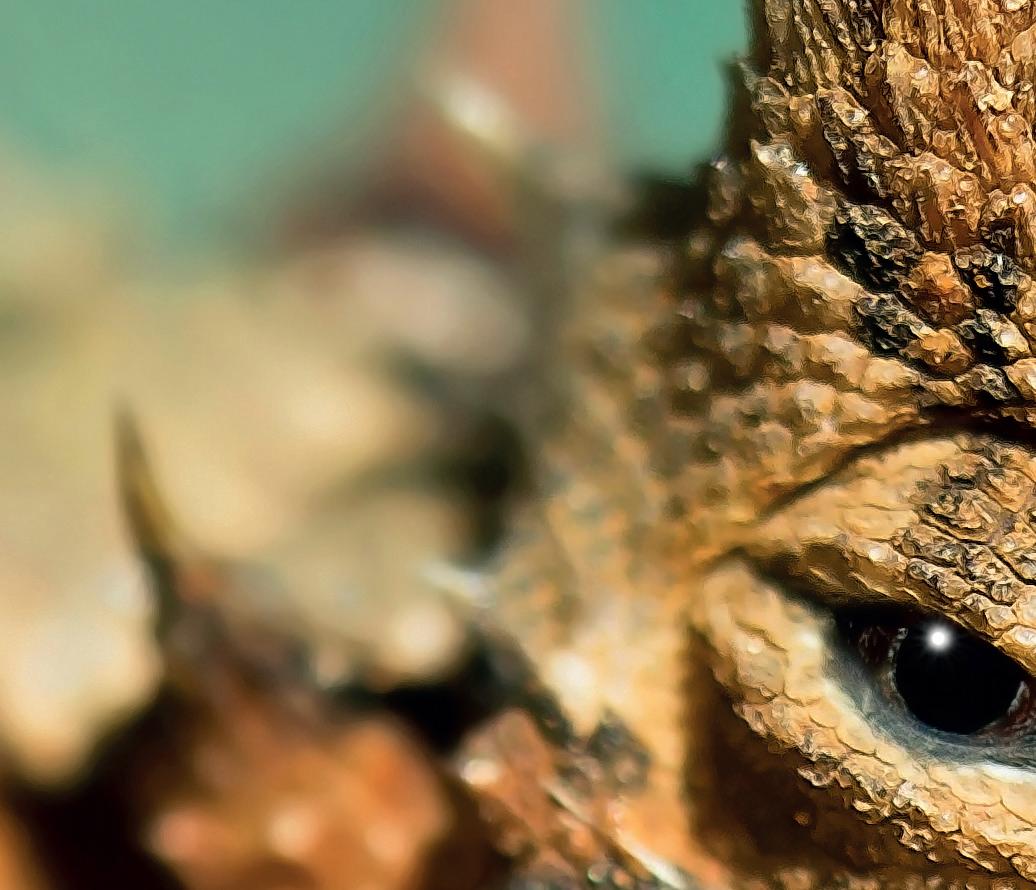


Rough-necked monitors bred in captivity in suspected UK first. How was it done and what does it mean for the future?
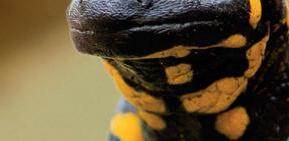
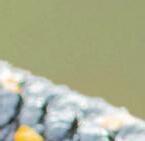
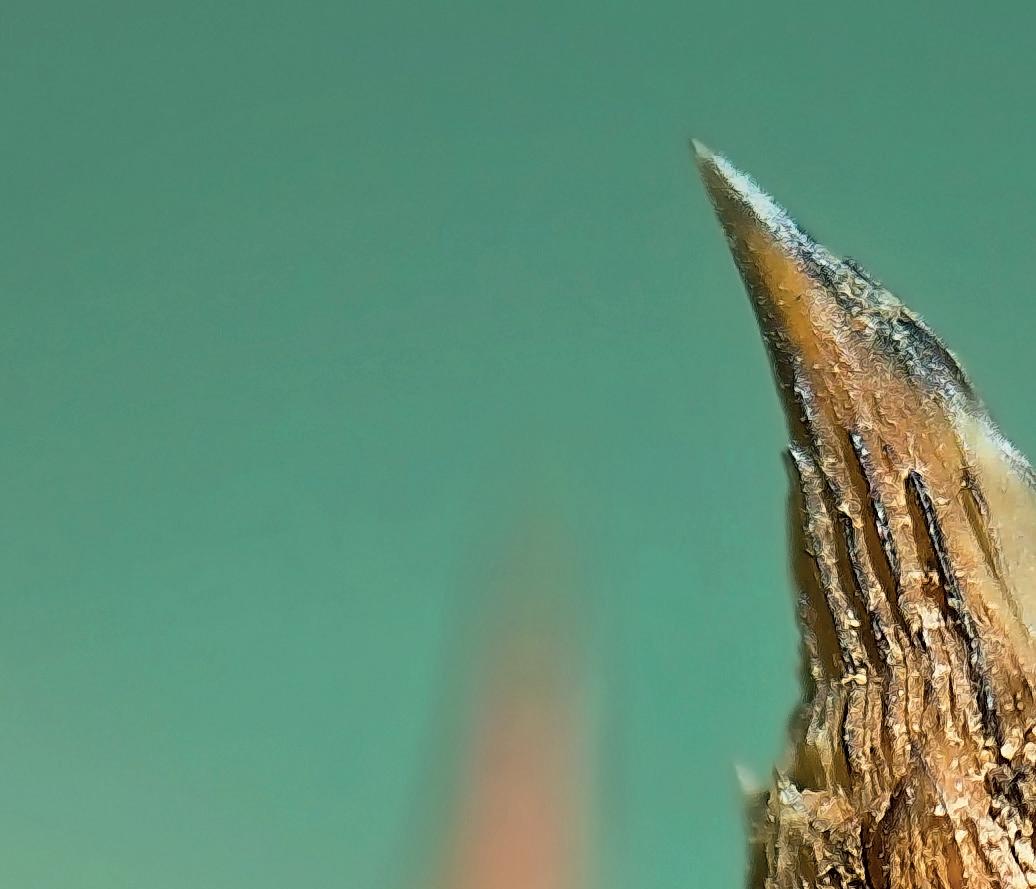

We look at the diverse species known as the ‘fire salamanders’ and how they developed to withstand dramatic landscapes.

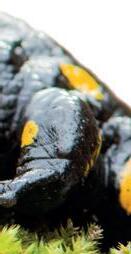
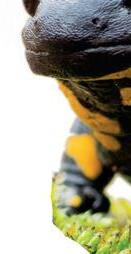
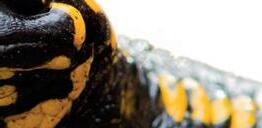




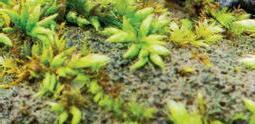

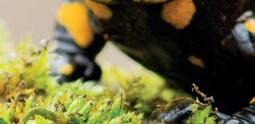



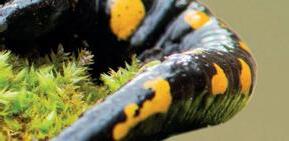
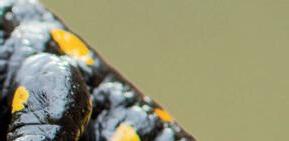
The complete line of Exo Terra®









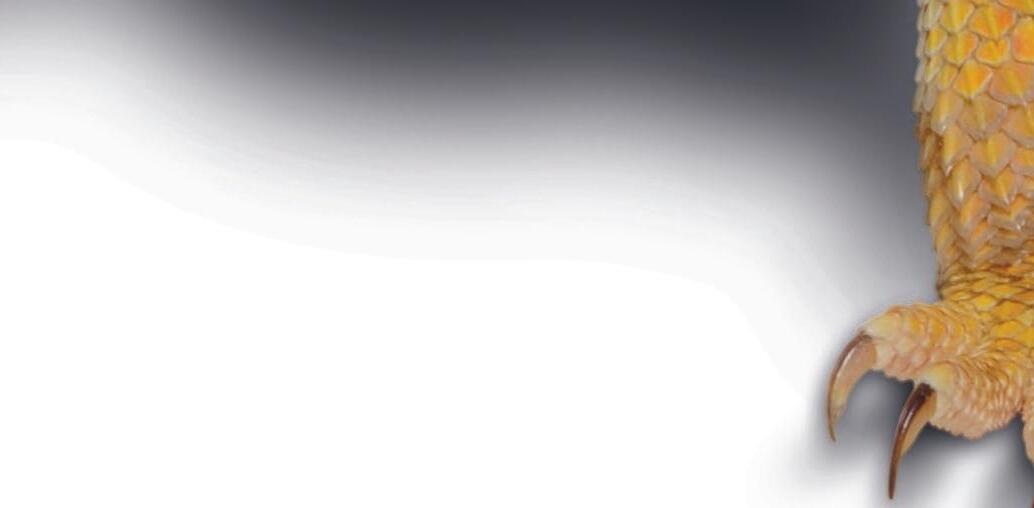





















Accurate temperature control is essential for your reptile’s health and wellbeing.




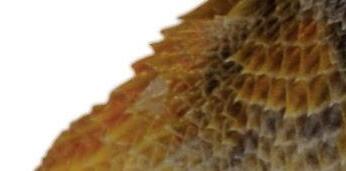


The new range of Exo Terra Thermostats makes regulating the temperature of your reptile’s home accurate, reliable and simple. With thermostats suitable for any heat source and utilising the latest technology with day/night timers and humidity control*, you can rely on Exo Terra to keep your reptile’s habitat perfectly balanced, 24 hours a day.
Available from all good reptile stockists nationwide. *Day/night timer and humidity control on selected models only
CONTACT US EDITORIAL ENQUIRIES hello@exoticskeeper.com
SYNDICATION & PERMISSIONS craig@exoticskeeper.com
ADVERTISING
advertising@exoticskeeper.com

MAGAZINE PUBLISHED BY Peregrine Livefoods Ltd
Rolls Farm Barns
Hastingwood Road
Essex CM5 0EN
Print ISSN: 2634-4682
Digital ISSN: 2634-4688
EDITORIAL:
Thomas Marriott
Aimee Jones
DESIGN:
Scott Giarnese
Amy Mather Subscriptions
As exotics enthusiasts, most of us will have had to defend our love for ‘scary’ animals many times. Well, if you can’t beat them, join them! In true October fashion, we’ve given this month’s EK a Halloween twist. Looking at the weirdest and most wonderful, this issue focuses on species shrouded in folklore. From fire salamanders stranded on mountains to blood-sucking vampire bats, cryptic monitors and the world’s strangest lizard, the thorny devil.

Subscribers will also notice that from the previous issue, we have expanded our page count to cram as much information into this magazine as possible. Expect this to continue, with extra mini features throughout.
In other exciting EK News, our team have been extremely busy visiting various zoos, conservation projects and breeding facilities to maximise our video content. Keep an eye out for an exclusive interview about the first Tuatara’s bred outside of New Zealand, as well
as features on Komodo Dragons, Call of the Wild Zoo, an update on Celtic Reptile and Amphibian and so much more. All our video content can be found on the Exotics Keeper YouTube channel and is the perfect accompaniment to each issue.
As always, thank you for reading. As a unique magazine reporting on niche interests, your support is valued greatly.
Thomas Marriott Features Editor

17 24 36
The latest from the world of exotic pet keeping.
06 THE DEVIL WENT DOWN UNDER
Will we ever get to see thorny devils on this side of the world?
16 SPECIES SPOTLIGHT
Focus on the wonderful world of exotic pets. This month it’s the King vulture (Sarcoramphus papa).
17

THE THIRST FOR BLOOD
Has our fascination with the supernatural warped our perception of bats?


24 A SONG OF ICE AND FIRE
We look at the folklore surrounding fire salamanders and their seemingly supernatural ability to withstand flames.


36 PROTECT YOUR NECK
Rough-necked monitors bred in captivity in suspected UK first.

45 FASCINATING FACTS
Did you know...?
46 BRITAIN’S DEADLIEST
Is there danger on our doorstep?
In Australia Taronga Zoo has released 187 critically endangered Northern Corroboree frog eggs into specially designed artificial pools created in the Brindabella Mountain Range - a sub-alpine region. In the next few weeks, these frog eggs will begin to hatch and in three to four years these same Northern Corroboree Frogs will reach sexual maturity where, hopefully, they will successfully breed and nest. This vital recovery effort is part of a broader conservation program aimed at ensuring the persistence of this beautiful species in the wild.
In June, the herpetology team at ZSL London Zoo celebrated the birth of eight Ethiopian mountain adders (Bitis parviocula), after two years of trying to breed this species. The adult pair arrived as juveniles in 2016.
First described in 1976, this species is believed to be endemic to the highlands of southwestern Ethiopia, between 1700 and 2800 metres above sea level. However, it is only known with certainty to reside in four locations in the country. With just four museum specimens available for study, important information regarding their conservation status and basic life history data are currently lacking.
Ethiopian mountain adders are so poorly known in the wild that they are yet to be assessed by the IUCN Red List. It is the first time Ethiopian mountain adders, native to the highlands of east Africa and known
from just a small handful of wild specimens, have been bred in a European zoo.
The adult snakes were mixed together intermittently over a two-month period as the gestation period was uncertain, although it does fall between 125 and 190 days. These healthy young snakes are very small compared to the adults, measuring between 23 and 28cm long and weighing an average of just 18g they will likely be over one metre long and weigh more than one kilogram when they reach adulthood.
With fewer than 50 other Ethiopian mountain adders in zoos around the world, these young snakes are an important addition to the global zoo population. The eight youngsters and adults will live behind the scenes for a little while longer before some will move to an on-show enclosure, whilst the rest will move on to other zoos in due course.

Top Award. Mr Thai Van Nguyen, the founder and director of the Save Vietnam`s Wildlife – a specialist rescue centre, has been awarded the prestigious Goldman Environmental Prize work his conservation work with pangolins. Between 2014 and 2020 some 1,540 pangolins have been rescued from the illegal wildlife trade. In addition since 2008 his anti-poaching team have destroyed 9,701 animal traps, dismantled 775 illegal camps, confiscated 78 guns and helped arrest 558 people for poaching leading to a significant decline in illegal activities in Pu Mat National Park.
The 1,000th captive-bred hazel dormouse has been released into the wild in the UK. As part of a long-term reintroduction scheme for these threatened mammals.
Once widespread, the animals
have now disappeared from 17 English counties. Reintroduction, scientists say, is the only way to bring dormice back to habitats from which they have been lost.

The project is a collaboration between the wildlife charity People’s Trust for Endangered Species (PTES), Natural England and the University of Cumbria. Together they have brought 15 breeding pairs to a secret location in the Arnside and Silverdale Area of Outstanding Natural Beauty in Lancashire. With its tangle of hazel, willow and bramble, the chosen Lancashire release site is ideal for the rodents.
Fifteen years ago there were five populations in northern England but today there is just one. The decline in woodland and hedgerows are contributory factors in the reduced populations.
It is hoped that we will end up with a population of possibly 70 or 80 animals in three very closely connected woodlands.
With the help of 200 extra carefully monitored dormouse nesting boxes installed in the woodland, as well as footprint tunnels placed along branches the rodents will use to move around the undergrowth, the team will be watching closely to see how well the animals settle into their new home. The 30 dormice in this most recent (and most northerly) release were bred and reared in captivity at London Zoo. They were kept in quarantine for nine weeks and thoroughly checked for disease or parasites, before being transported more than 250 miles by car. The animals travelled in special dormouse nest boxes that were handmade by prisoners in HMP Doncaster and Humber - as part of a partnership between the PTES and the Department of Justice.
The Aspinall Foundation have announced that they plan to send 13 African elephants from Howletts Wild Animal Park in Kent on a journey of over 4,350 miles to Kenya in 2022. This will be the first time this has ever been attempted.
The group ratio is 5.8 animals; from the oldest 34 year old matriarch “Tammi” down to the youngest animal - 1 year old male “Nguvu”. The Kenya Wildlife Service and The Sheldrick Wildlife Trust are both said to be involved, however they have apparently not yet been approached by the Aspinall Foundation about this future plan.
Meanwhile in the Bateke Plateau National Park in Gabon an infant western lowland gorilla has been born in the wild to female “Mayombe” and male “Djongo” – this is said to be the first wildborn offspring from a captive bred pair of gorillas returned to the wild.
Mr Thai Van Nguyen, the founder and director of the Save Vietnam`s Wildlife – a specialist rescue centre, has been awarded the prestigious Goldman Environmental Prize work his conservation work with pangolins. Between 2014 and 2020 some 1,540 pangolins have been rescued from the illegal wildlife trade. In addition since 2008 his antipoaching team have destroyed 9,701 animal traps, dismantled 775 illegal camps, confiscated 78 guns and helped arrest 558 people for poaching leading to a significant decline in illegal activities in Pu Mat National Park.

ZSL London Zoo was awarded several certificates - a gold in the category for behaviour and welfare with their “Evidence-based reptile behaviour and welfare” programme. A second gold, this time in the Animal Husbandry, Care and Breeding category was awarded for their project “Optimising calcium supplementation regimens in mountain chicken frogs (Leptodactylus fallax). A third gold award, in the same category was given for their project “Maintaining caecilians in captivity furthers our understanding of a poorly known taxon”
In the Behaviour and Welfare category award, ZSL London Zoo won a silver award for their project “Window on life: Training okapi for early pregnancy detection and monitoring using ultrasound, to facilitate husbandry decisions and improve welfare”.
Finally another silver award in the Field Conservation category, was presented for their project “Describing unknown amphibian life stages“.
Meanwhile at ZSL Whipsnade they received a bronze award in the Animal Husbandry, Care and Breeding category for their project “Foetal Doppler Training with a White-Faced Saki Monkey”.
A silver award in the Animal Husbandry, Care and Breeding category - was presented to Bristol Zoo Gardens for their project “Management and first UK Zoo breeding of the blue tree monitor (Varanus macraei) at Bristol Zoo Gardens”
Jersey Zoo gained a silver award in the Behaviour and Welfare category for their project “Development of Radio Frequency Identification Devices to Remotely Monitor Weight in Captive
Websites | Social media | Published research

Livingstone’s Fruit Bats (Pteropus livingstonii)”
A gold Field Conservation award was presented to Jersey Zoo for their project “The Mauritius MV Wakashio oil spill response - emergency rescue and establishment of reptile safety populations at Jersey Zoo”.

Chester Zoo. Firstly a gold award was given in the Animal Husbandry, Care and Breeding category, for their project “Breeding the Omani blind cave fish using assisted reproduction”, in addition a silver award was presented in the category of Behaviour and Welfare for their project, “The value of longitudinal behavioural monitoring programmes”.
A silver award in the Field Conservation category was presented to Chester Zoo for their project “A ‘One Plan’ research approach to inform the recovery of the Critically Endangered Bermuda Skink (Plestiodon longirostris)”
Collated and written by Paul Irven.
THIS MONTH IT’S: EXOTICS KEEPER
Yes, this month we wanted to share our own social media page. Join us for up-to-date news, exotic care tips, exclusive videos, and a growing community of friendly exotic animal lovers.
www.facebook.com/ekmagofficial

Each month we highlight a favourite website or social media page










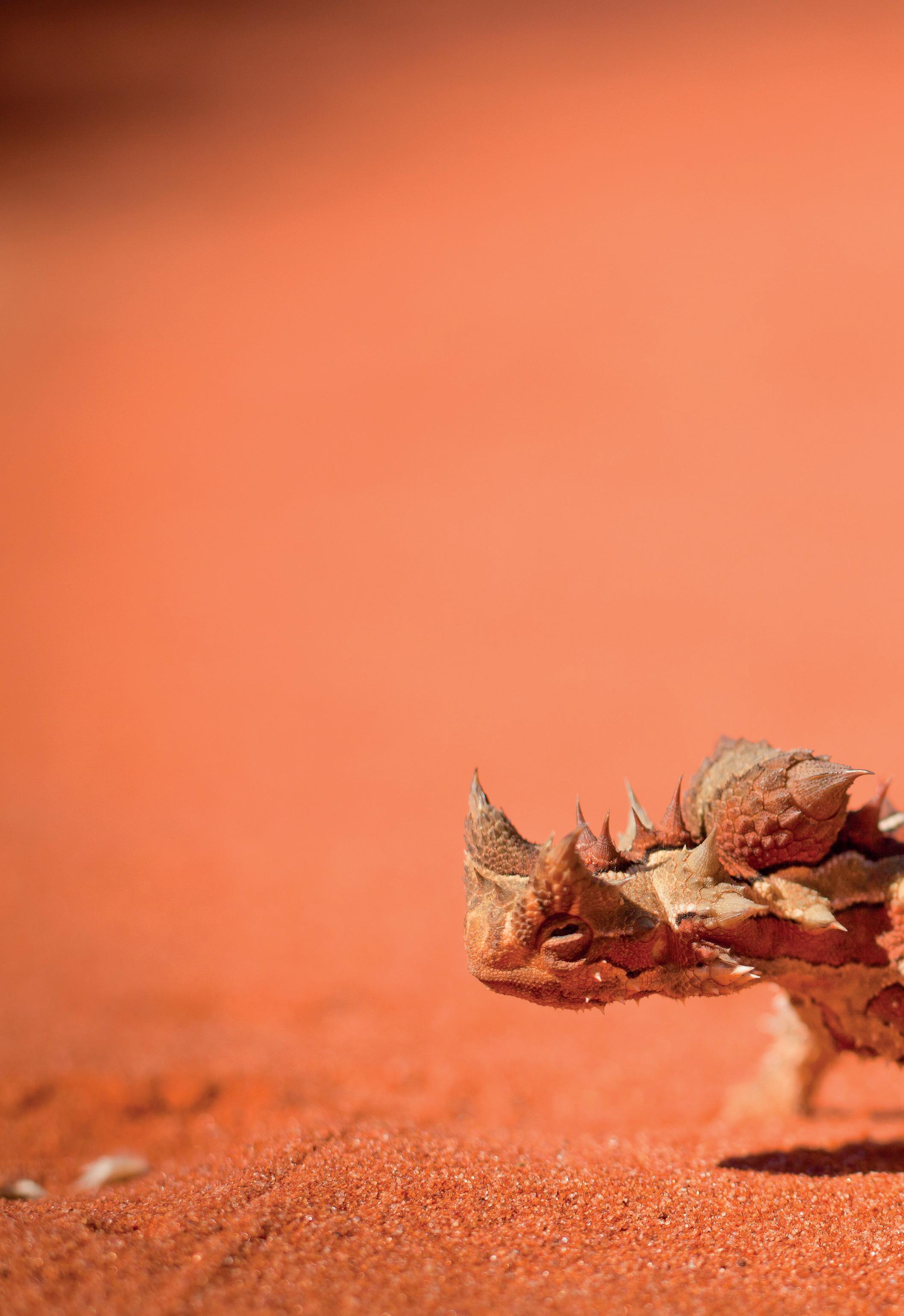
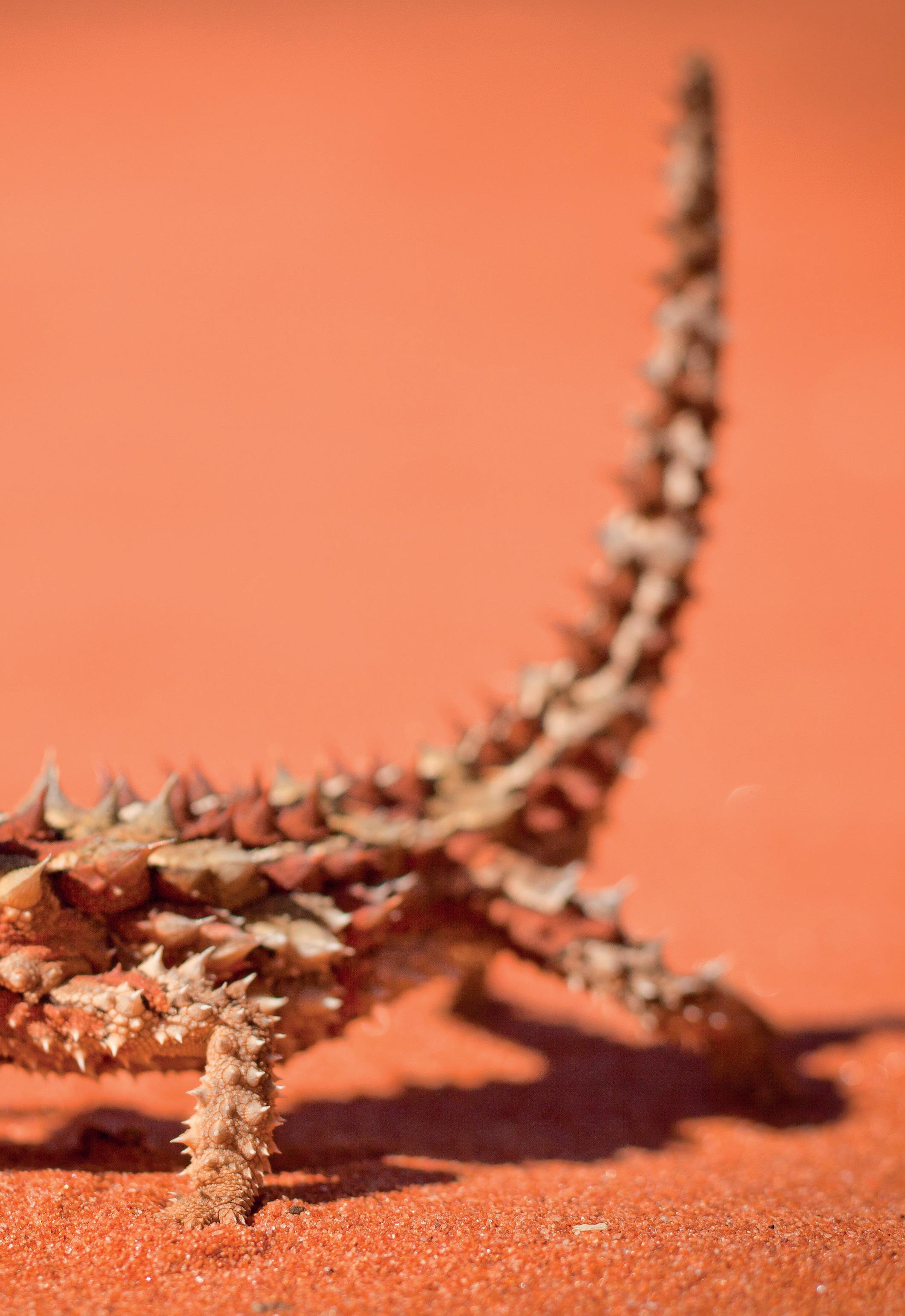
Isolated from Gondwana some 100 million years ago, Australia has been responsible for producing some of the most obscure and unusual animals on the planet. The thorny devil (Moloch horridus) is very possibly the strangest of these animals and one of the weirdest-looking vertebrates on the planet. Its quirky adaptations are the lizard’s greatest strength, allowing it to inhabit some of the most hostile environments on the planet. In fact, thorny devils are so specially adapted that it is practically impossible to ever keep this species in captivity outside of Australia.
The name ‘Moloch horridus’ comes from the Caanite god ‘Moloch’ from John Milton’s epic, Paradise Lost. Horridus is also loosely translated from latin to mean ‘rugged’ or ‘dreadful’. Despite their fearsome appearance, these lizards only grow to around 20cm in length and live exclusively on a diet of ants. They are found across a huge area of Australia that extends right from Australia’s West Coast, deep into the heart of the country, covering areas in South Australia, Western Australia, Northern Territory and some of Queensland. However, they only inhabit areas made up of sandy soil or sandy loam soil.
Aside from the stunning spines they possess, thorny devils are also variable in their colouration. Usually, a brown or olive animal in the morning, these lizards will end up ‘firing up’ as the heat intensifies, bringing out vibrant orange and yellow pigment later in the day. Observations also suggest their thermoregulation is conducted largely through posture. When they hope to warm up, they will place their smooth bellies onto warm surfaces and when they wish to cool down, will use both arms to hold their body off the ground, by grasping onto spinifex grass.
Thorny devils have also developed a ‘false head’ that they use as a defence mechanism. This bony mass on their neck confused scientists for a long time as it cannot be dropped or detached. Instead, it is thought that the sheer size of this intimidates smaller predators and its obvious lack of vital organs such as the brain makes it a preferable target should the lizard be attacked. The ‘thorns’ of the thorny devil are also made of keratin and are genuinely sharp. Skin that is shed from atop the thorns retains its conical shape, making the shed ‘thorns’ of the thorny devil just as aesthetically interesting as the lizard itself.
Daniel Rumsey is a Keeper at The Australian Reptile Park. His wild observations of thorny devils add some realism to the mystical appearance of these animals. Dan explained: “Thorny devils are found in semi-arid grasslands and along sand ridge deserts. In the areas I have encountered them, they seem to occur in fairly good numbers.” The IUCN recognises thorny devils as ‘Least Concern’ due to their wide distribution. However, their strict diet of ants means they are extremely reliant on a healthy ecosystem, leading some to consider localised populations as ‘vulnerable’.
Dan continued: “In saying that, the majority you find are animals struck and killed by cars. These aren’t the only threats that this species faces in the wild. Monitor species and birds of prey will predate on them. The thorns are no match for a voracious varanid or power beak of a raptor.”
Their iconic appearance means that thorny devils are often an
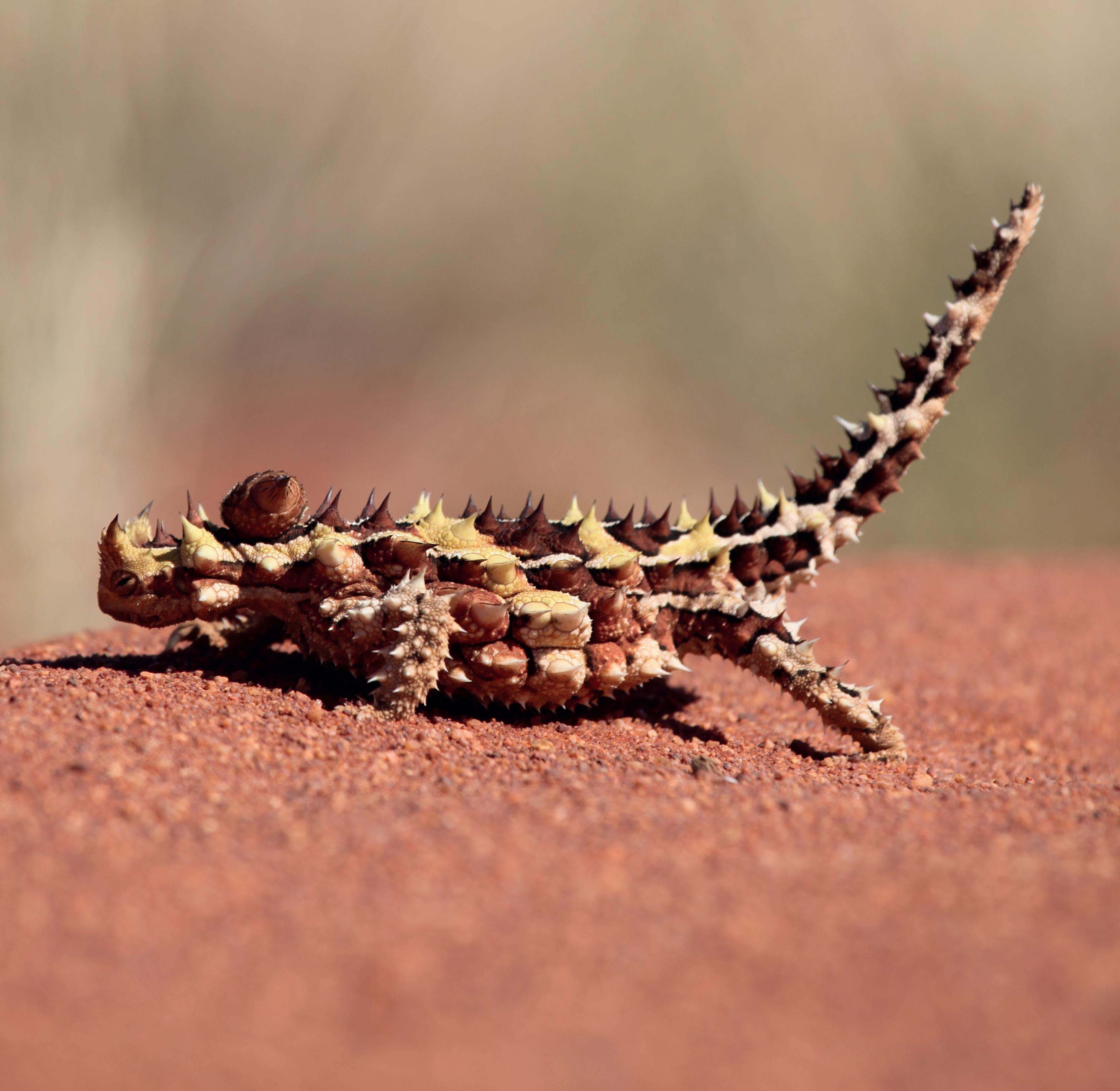
interesting subject for enthusiasts all over the world. As a species that inhabits such harsh conditions, thorny devils can be the catalyst for much needed conservation efforts in remote areas, despite their seemingly abundant numbers. Dan continued: “I believe they are well received as an iconic Australian species which sparks a lot of research and interest from both
the scientific community and the general public. This would have to be one of the main target species of any budding reptile enthusiast. I think there are lots of new areas of study that could be interesting around this species. They are a wonderful example of convergent evolution, and we see this more and more across many taxa. There is a vast space to continue to gain knowledge in this vast topic.”

Convergent evolution is a process that causes animals from entirely different areas of the world to adapt similar traits due to similar environmental conditions. This is very apparent when looking at the North American horned lizards (Phrynosoma). Both Moloch and Phrynosoma have adapted to harsh environments with constant threats from aerial predators.




Thorny devils (referred to as Arnkerrth) hold significance to the Anmatyerre and Alyawarr people who have a dreaming story about the animal. The story explains that the thorny devil is responsible for the creation of coloured ochres. These pigments are still used today for ceremonial paints.





Thorny devils also play a pivotal role in many aboriginal artworks. Their colouration, their tracks, the spinifex grass they reside in, and their striking outline are often the subject of many different paintings from different aboriginal communities across Australia.
The more we learn about thorny devils, the higher the likelihood of being able to exhibit this animal across the world. They are the epitome of adaptation for harsh environments and few animals on planet earth are better suited to a challenging lifestyle than the thorny devil. Although herpetoculture in both zoos and the private sector is a continually developing process, reminding ourselves that there are species too specialist for captivity across the world is a humbling reminder of our relationship with nature.
Despite being separated by about 150 million years and Moloch being an agamid and Phyrnosoma being an iguanid, both lizards use a similar technique to hydrate themselves in the harsh deserts they inhabit. Both possess a tubular inter-scalar network of channels that essentially absorb and channel water around the body. Movement from the jaw and tongue then pump this water towards the animal’s mouth, which is assisted by the secretion of water-absorbing mucous. This niche way of drinking has been covered in wildlife documentaries and seems utterly absurd that one species does this, let alone several from two opposite sides of the planet.














Furthermore, Phrynsoma species are also extremely partial to an ant-based diet. Although they don’t feed exclusively on these, they have adapted to eat huge volumes of tiny prey. As these tiny insects are nutrient lacking, both the horned lizards and the thorny devils have developed huge stomachs to ensure they can retain as much nutrients as possible. This diet also means the two genera have extremely similar jaw, neck, and teeth structure. Having a slender mandible with little area for jaw attachment is something that can even be seen in mammals when looking at anteaters (Myrmecophaga .sp & Tamandua) and pangolins (Manis .sp).

 The Devil Went Down Under
The Devil Went Down Under
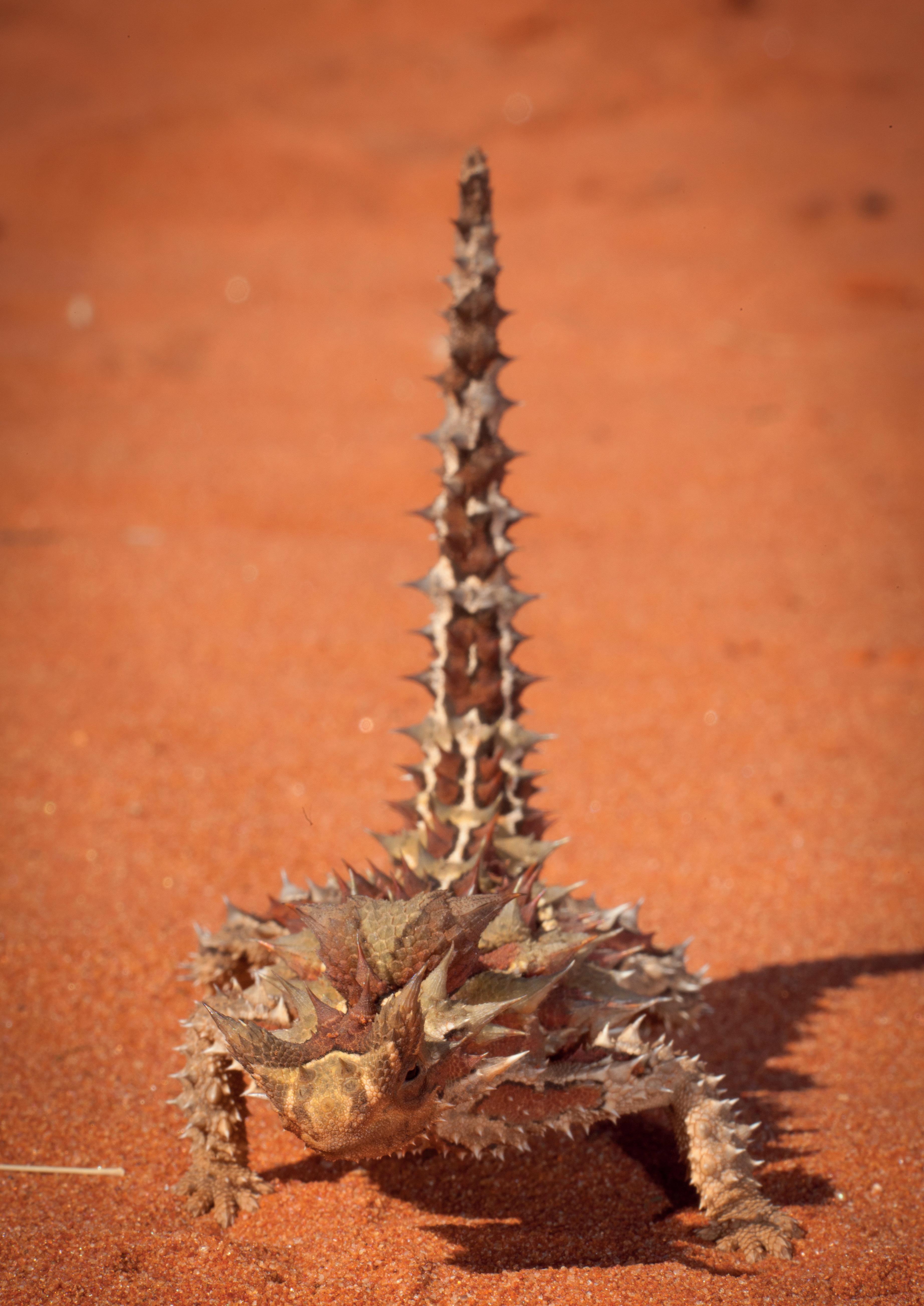
“They are an incredible species that I would love to see zoo visitors enjoying around the world. If there is a way to supply their diet to zoos, I do not see why it would not be possible to exhibit thorny devils.”
One thing almost all reptile enthusiasts across the world will have come to terms with by now, is that they are unlikely to ever see a real, live thorny devil. However, some enthusiasts are lucky enough to work with these animals every day. Lauren Hunter is a Reptile Keeper and Professional Snake Catcher at Alice Springs Reptile Centre. After studying her BSc in Animals Science in South Australia, Lauren moved to Alice Springs as a Senior Keeper in 2019. As well as relocating some of the world’s deadliest snakes, Lauren also cares for one of two of the only captive populations of thorny devils in the world.
“I absolutely love my job” explained Lauren. “The Centre has been operating for roughly 20 years now. We have such a wide variety of native Australian reptile species on display and pride ourselves in providing a fun and educational hands-on experience for our visitors.”
“Thorny devils are a common sight in sandy habitats in Central Australia, WA and SA. So, we mainly keep thorny devils to introduce visitors to this amazingly unique species. They are the most requested reptile when visitors come through our doors. The Alice Springs Desert Park here in Central Australia is also successful at keeping thorny devils. As for breeding, I believe they have a juvenile right now. Other than this organisation and The Alice Springs Reptile Centre, I am not aware of any other zoos keeping thorny devils. We currently house six at present and have observed mating behaviour, so we are keeping all our fingers and toes crossed for the pitter patter of tiny thorny devil feet!”
It is no secret that thorny devils are extremely specialised in their requirements. However, with other centralian species such as bearded dragons ( Pogona vitticeps) and Bredl’s pythons (Morelia bredli) doing extremely well in captivity,
Lauren continued: “The main challenge in keeping thorny devils is their diet. Thorny devils exclusively eat black ants. There are around 7 species of black ants however thorny devils have been known to preferentially eat three species within this genus. At the Alice Springs Reptile Centre we are able to overcome this challenge as we have the exact species of ant on site. Therefore, instead of considering these ants a pest and baiting to get rid of them, we bait to lure the ants into the thorny exhibit. Any leftover food from our other reptiles or even from staff lunches, is used to attract ants into our devils’ environment. An individual thorny devil will eat thousands of black ants in just one day! Therefore, another challenge can be sourcing enough ants. In order to overcome this, we have multiple areas where we lure ants to such that the thorny devils can be moved when one ant supply is running low.”
With thorny devils relying so heavily on such a specialised diet, it has led some researchers to suggest they are threatened. Despite good population numbers their vulnerability is increased by such a heavy reliance on just three species of prey.

Alice Springs Reptile Centre is located in one of the most remote cities on Earth. Although this presents lots of opportunities to provide natural husbandry and outdoor enclosures for exotic reptiles, it also brings its challenges.
Lauren added: “We have both indoor and outdoor enclosures for the majority of our small and vulnerable reptiles due to the weather and temperature here in Alice Springs. If it is too cold or too hot outside, we can bring the thorny devils inside to ensure they are not subject to extreme weather conditions. We also have transportable termite mounds that we bait, put outside to collect ants and then place in the indoor thorny enclosure so
Thorny devils have previously been illegally exported in the 70s with keepers attempting to keep them on sand, with micro crickets as a diet. Unsurprisingly, these animals did not last long. Since we have learnt more about their niche requirements, illegal exports

seem to have subsided. However, it appears that their quirky appeal also resonates with local people in the area. Lauren explained: “Naturally, we don’t find this species close to the town. However, we do get called on the snake catcher phone to pick them up when they
have been illegally picked up and brought into Alice Springs.”
Although thorny devils do require specialist care, Lauren is optimistic that advancements in care and live food breeding may one day allow zoos across the world to exhibit these unusual animals. Lauren concluded: “They are an incredible species that I would love to see zoo visitors enjoying around the world. If there is a way to supply their diet to zoos, I do not see why it would not be possible to exhibit thorny devils. Zoos have mimicked the environment of exotic species for years. Given the right conditions, a reliable food supply and a stress-free environment any species will thrive.”
For those planning a herping trip to Australia, the best months to spot thorny devils are from March to May. During this time they will travel vast areas in search of a mate, meaning they are regularly spotted on roadsides up the West Coast and through Central Australia. Generally, the hottest months of January and February and the coldest months of June and July prompt thorny devils to remain relatively inactive.
Despite their obscure appearance, thorny devil reproduction mirrors many other agamids. Just like bearded dragons (Pogona .sp), thorny devils will head bob and wave their hands to attract a mate. After courtship the female will lay up to 10 eggs in a burrow deep in the sand to protect them from harsh conditions. It has been reported that the mother will actively smooth over the sand near to the burrow to hide them from predators. After an average of 118 days, the young will hatch. Sexes will be determined by temperature and the offspring are reported to feed on their eggshell before developing a diet of ants almost instantly after leaving the burrow.
With 20 years of research and development Repashy Superfoods have refined the ultimate range of premix reptile diets, inset gutload formulas and supplements. Fortified with vitamins, trace elements and minerals.
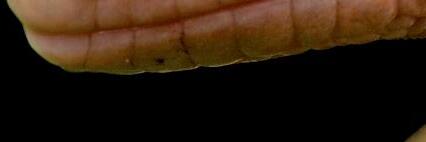
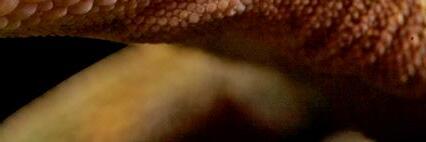

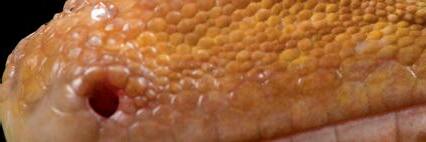
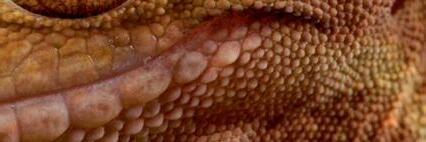
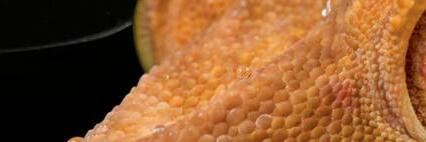
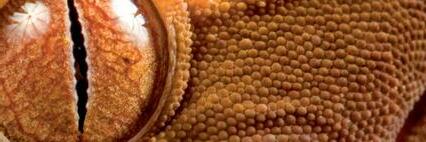

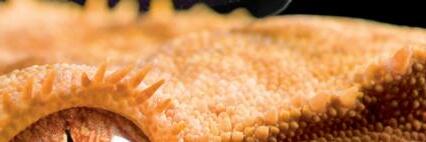





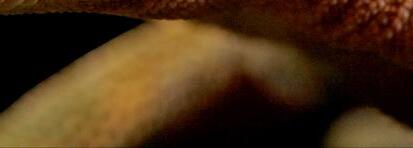









































The King vulture is a perfect example of an animal considered both grotesque and beautiful. Ancient Mayan legends considered this bird the messenger between people and the gods. As the name suggests, the King vulture is one of the largest scavenging birds. With a wingspan of up to 2m, other vultures give way to them as they arrive at a carcass.
King vultures can be found throughout Central and South America, from Southern Mexico to Northern Argentina. This area is approximately 14 million squared kilometres, prompting conservationists to consider king vultures to be of ‘least concern’. They typically inhabit grasslands and tropical forests, in small groups and exhibit minimal sexual dimorphism. Both sexes possess the same fleshy orange caruncle and black and white plumage.
Vultures play a pivotal role in the ecosystems they inhabit. Being scavengers, they have evolved to possess highly acidic stomach juices, making them
lost their feathers to allow the animals to bury their heads deep in the decaying flesh.
Interestingly, king vultures make wonderful parents. The female will lay a single egg in a nest on the ground, which both parents will protect and nurture until the chick fledges the nest. Being such fearsome birds, with so few competitors or predators, the parents can dedicate all their efforts towards a single offspring. This youngster will not develop the trademark orange colouration until they are upwards of three years old.
Although king vultures are widespread and officially considered ‘least concern’ many researchers from various countries within their range believe they are facing population declines. Deforestation and habitat destruction throughout South America is contributing to huge declines in biodiversity and cryptic species that often fly at altitudes too high to fully observe are at risk.
Has our fascination with the supernatural warped our perception of bats?

From terrifying monsters to teen heartthrobs, our society has been in awe of vampires for hundreds of years. Popular culture is continually transforming our perception of what a ‘vampire’ is and yet one constant theme is the everlasting thirst for blood. This narrative bleeds into science, as some species exhibit hematophagy, the practice of feeding on blood.
There are three species of vampire bat, all residing in Latin America. Of these three, only Desmodus rotundus has been known to feed on mammals. However, all three evolved from fruit-eating bats and developed a very rare taste for blood. The practice of feeding exclusively on blood is generally uncommon in the animal kingdom, rare amongst vertebrates and practically unheard of within mammals. Of course, the vampire bats break this trend.
Blood is around 93% protein. Yet, it is less than 1% carbohydrates and very low in nutrients. Furthermore, there are countless blood-borne pathogens and bacteria that can be found in blood. In fact, after carrying out a full hologenome analysis, researchers found that the droppings of D. rotundus contained over 280 bacteria known to cause disease in other mammals (M. Mendoza et al 2018).
This led the team of researchers to explore what it is that allows the common vampire bat to thrive on a sanguivorous (blood-based) diet. The paper reads “it is clear from our results that the common vampire bat has adapted to sanguivory through a close relationship between its genome and its gut microbiome.” These findings may represent a bigger picture for how we study the adaptations of all animals. By failing to consider the gut microbiome when looking at genetics, we fail to paint a true picture of how that adaptation came to be.
One myth that surrounds vampire bats, is their
method of drinking blood. In fact, there are some similarities with the fantasy stories of ‘blood-sucking’ humanoids from Transylvania. Vampire bats will create an incision on their prey (often large hooved stock that rarely feel it) with their teeth, then proceed to lick this with their tongue. It is quite common to hear that vampire bats ‘don’t suck blood, they lap it up’, yet this is not entirely true either. Both Desmodus and Diaemus have capillaries within their tongues, which creates a groove that can ‘suck’ blood. A feed can last anywhere up to 30 minutes, with the tongue touching the wound/blood flow up to 900 times before the unsuspecting victim wakes up. Not all feeding is done whilst the prey is asleep, with cumbersome mammals such as sea lions, being harassed throughout the night before the bats get their feed.
To access the most subtle or poorly defended areas of their prey, vampire bats have developed the ability to walk and jump which is generally unusual for bats. They will land close to their victim before quietly sneaking up to them from a nearby ledge.
For all their gruesome traits, common vampire bats could be considered generous animals. Their nutrient and carbohydrate-poor diet mean that feeding every night is an absolute necessity. One night without blood can be fatal to a vampire bat. Therefore, these animals will regurgitate blood to share with other bats if they have had an unsuccessful night. Colonies are comprised of up to 100 bats that will groom each other after returning from a feed.
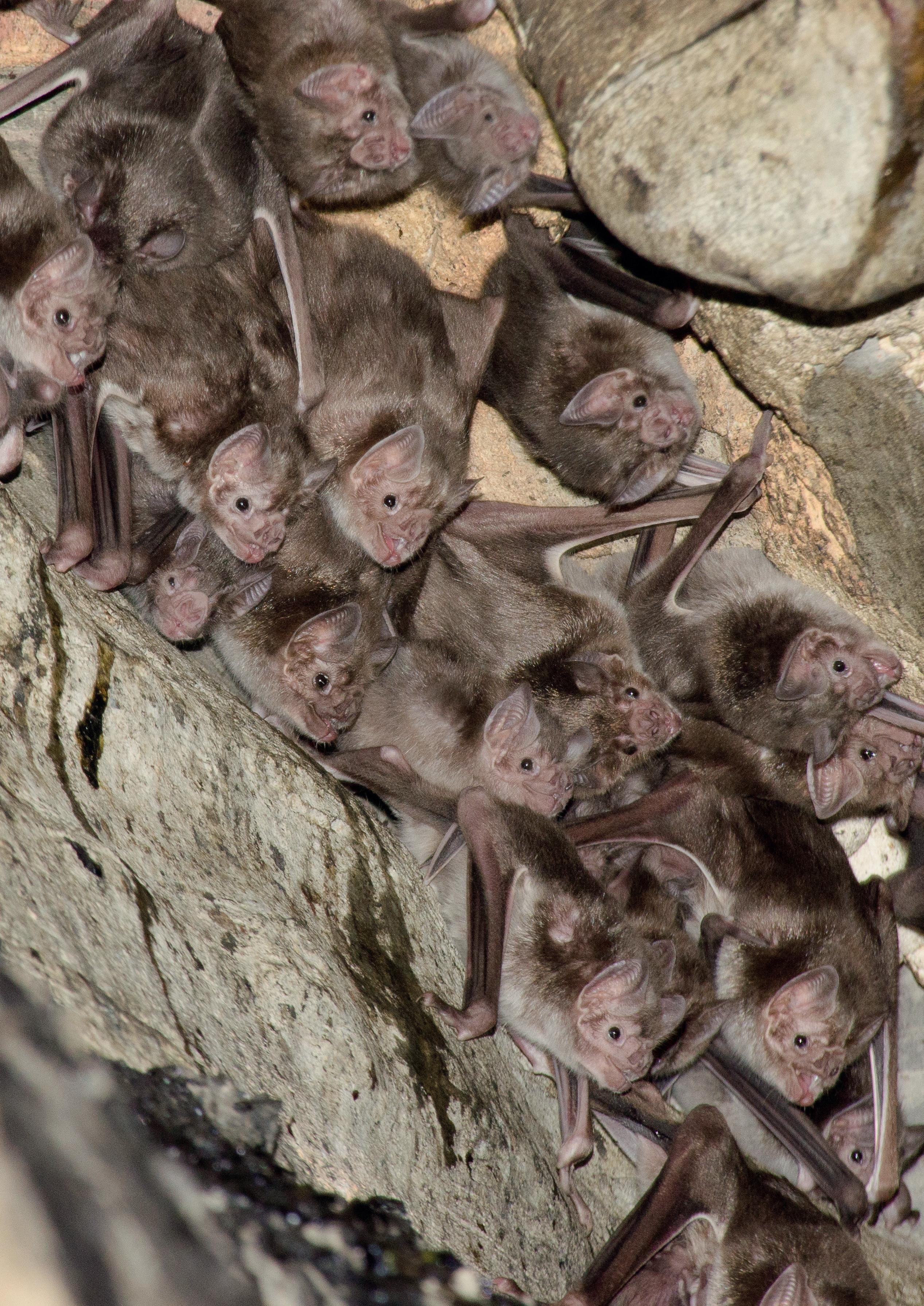
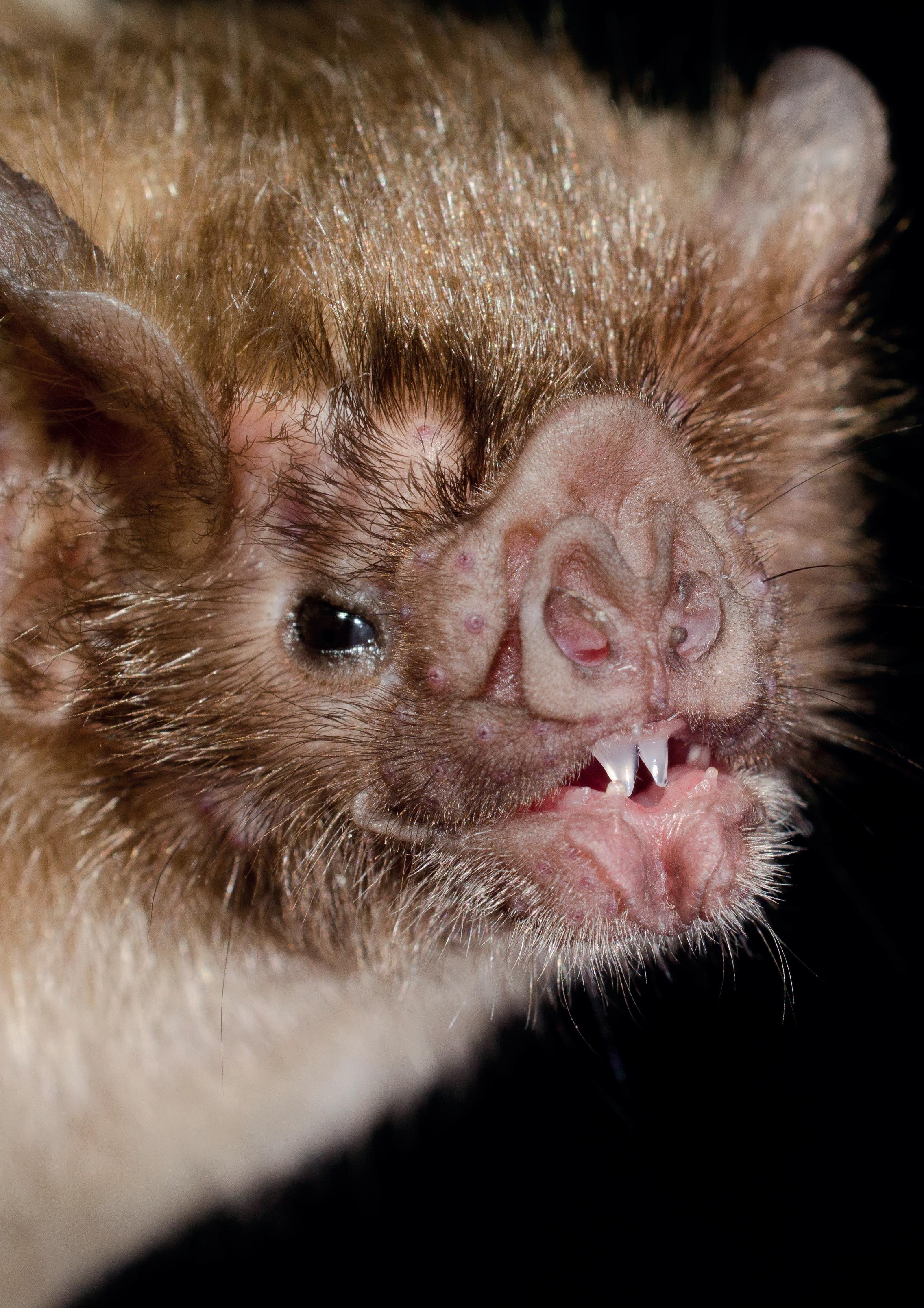
Bats have been the media focus of many zoonotic diseases in recent years. While they pose almost no risk to humans here in the UK, rabies is a prominent disease in the tropics. In Latin America, particularly Brazil, battransmitted rabies is on the rise. With major efforts to control the spread of dog-transmitted rabies since the 1980s, the number of bat-transmitted cases exceeded those transmitted by dogs in 2004 and increased ever since. In fact, 2005 saw just 13 cases of dogtransmitted rabies, compared to 60 cases of bat-transmitted cases.
Wilson Uieda is a Professor of Zoology at Sao Paulo State University and leads the Bat Conservation Programme of Brazil. He states, “the problem of humans being bitten by vampire bats and thus at risk of rabies transmission has existed in Latin America for centuries, although recently there have been increased reports of human rabies transmitted by the common vampire bat D. rotundus, especially in the Amazon regions of Brazil and Peru.”
Riverine communities, particularly those that sleep in open hammocks within open wooded houses are at an increased risk of being fed upon by D rotundus
Feet and toes tend to be the most common area to be bitten, but some instances of bites upon the face have occurred. Naturally, this can lead to significant trauma and scarring.
“A study of those outbreaks, for which a report was published with information on where they occurred, shows that most of them shared the same conditioning factors. We divide these factors into two interrelated groups: biological and nonbiological. Biological factors include the presence of vampire bats, the existence of adequate shelter
for them, the availability of food sources, and the presence of rabies virus in the area. Nonbiological factors include the type of human productive process and changing patterns in such activities, working and living conditions, access to rabies prophylaxis (medication), and measures being implemented to control bat populations.”
As the name suggests, common vampire bats are abundant throughout Central and South America, with population numbers on the rise, largely fuelled by agriculture. In well-preserved forests vampire bats are rare. This is because most South American mammals have some nocturnal behaviours, making feeding difficult for the bats. The hunting of wild mammals in these areas also reduces bat population numbers. Where there is more domesticated livestock, there are more feeding opportunities as well as nesting areas for the bats.
Although bat-transmitted rabies is a genuine risk in South America where vampire bats live, our native species here in the UK are entirely insectivorous. Furthermore, the UK is regarded as a ‘rabies free’ country. Whilst stories of blood-sucking vampires can inspire some wonderful areas of study and unearth some truly fascinating aspects of natural history, the misinformation surrounding it can negatively impact vital conservation efforts.
Alex Morss, Communications Officer at the Bat Conservation Trust reassured us: “A very small number of bats in the UK have been found to carry rabies type viruses called European Bat Lyssaviruses (EBLV). EBLV are not the classical rabies virus that is usually associated with dogs. Classical rabies has never been recorded in a native European
bat species. There has only been one known human case of EBLV in Britain in the past 100 years. The presence of EBLV in bats in the UK does not affect the UK’s rabies-free status as this relates to classical rabies only. Bats are not normally aggressive and will avoid contact with humans. This means that there is no risk if you do not handle bats.”
Although much of the rhetoric surrounding bats in mainstream media recently has been negative, awareness campaigns explaining their role in our world’s ecosystems are also growing. Despite countless challenges brought on by disease, the threat of climate change and the importance of preserving biodiversity is becoming much more well-known.

Alex continued: “Bats play vital roles in ecosystems. In tropical countries, many plants and crops rely partly or wholly on bats to pollinate their flowers or spread their seeds. European bats feed mainly on insects. This brings many benefits to humans, like helping to control insects, some of which can damage crops and gardens and carry diseases such as malaria. Studies have shown that bats save farmers billions of dollars in pest control every year as they are prolific insect eaters. They are also vital as seed dispersers and reforesters. Their poo, called guano, is also valuable as fertiliser.”
“Bats are important indicator species that tell us about the health of the environment. They are vital pollinators for at least 500 plant species, including many foods that we love, such as mango, banana, durian, guava and agave [which is used to make tequila). Many of the foods in our kitchens are either provided by or grown with help from the roles of bats.”
Although vampire bats do pose a very real threat of disease transmission in developing countries, particularly in South America, this fearmongering has created new challenges for conservationists working with bats across the world. In fact, it is much more likely that our actions pose a greater risk to bats, than the other way round.


Alex Morss, Press and Communications Officer at the Bat Conservation Trust told Exotics Keeper Magazine “There are some big misunderstandings around bats, particularly on diseases. Sadly, this has resulted in bats being unfairly persecuted in several countries. It is important to dispel widespread unfounded fears and myths about bats because it directly threatens their conservation, and bat persecution can also have wider impacts on people and other wildlife.”
“Recent research has shown we increase the risk of zoonotic disease-carrying pathogens crossing species barriers into humans when we destroy or degrade natural environments, exploit, stress or destroy ecosystems and their wildlife.”
Here in the UK, there are 18 species of bats a`s well as one Greater mouse-eared bat (Myotis myotis) that has been discovered in the South of England, since it was officially described as extinct in 1990. All species have previously seen population declines and misinformation and fear has accelerated this. Now, with protection at governmental level, things are starting to change.




Alex explained: “One of the biggest threats to bats is habitat
loss. This can be subtle because they are a cryptic, nocturnal species and we don’t often see or hear



mammal species and nearly 25% of British mammal species. [1,400 species worldwide; 17 breeding species in Britain]. We monitor trends for 11 of our 17 species. The good news is that in the UK, we appear to be seeing slow recovery
them in many parts of the world, so it’s easy to overlook them when they are roosting quietly in trees or buildings. Those hidden roosts are vital and legally protected bat habitats. For this reason, to protect bats and follow the law in Britain, it is essential to seek advice from a suitably qualified bat ecologist before carrying out building work or tree removal that might harm them. In Britain, all of our 17 breeding bat species and their roosts are legally protected. No-one should be handling or disturbing bats without first having training and a licence, so all those who do, will be doing so safely following good practice, for themselves and importantly for the welfare of the bats. “
“It’s worth remembering that bats make up over 20% of the word’s

following decades of decline last century, thanks to better wildlife protection laws and practices. Our National Bat Monitoring Programme reveals population trends for 11 breeding bat species. All of them are considered to have been stable or to have increased in the last 20 years.”
“However, some other British bats remain at risk, and globally we don’t have enough data on all 1400
species to be able to protect them. In Britain, for example: the grey long-eared bat is endangered; the barbastelle bat and serotine bat are both considered vulnerable; the Leisler’s and Nathusius pipistrelle are both near threatened. We don’t yet know the conservation status of several others because of too little data, including the Alcathoe bat, Brandt’s bat and whiskered bat.”
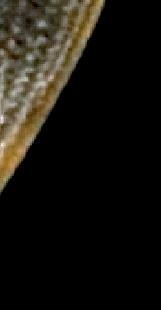



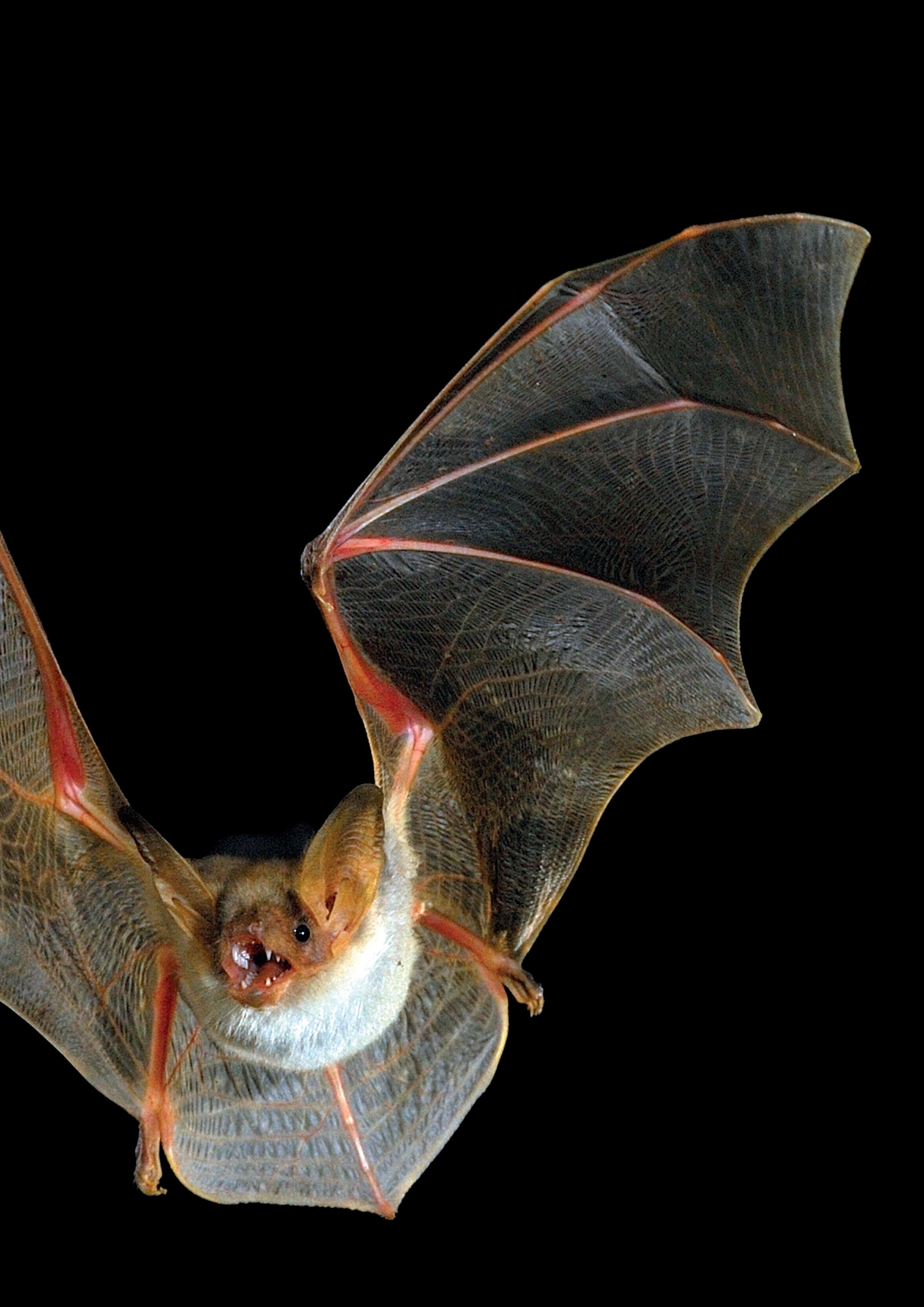
Exotics enthusiasts know all too well how misunderstood our beloved reptiles, amphibians and invertebrates are and bats are no different. With the correct protection laws being put in place, as well as a shift in public attitudes, hopefully bats across the world will be better understood and appreciated for their ecological significance.
Alex concluded: “Bats are amazing, and many are also threatened, so they need our support more than ever. I am in awe of them, no-one who understands them




and how incredible they are, how gentle and harmless they are, and all of the benefits they bring, could fear them. Bats are lovable and appreciated by anyone who takes the time to watch or listen to them or understand how amazing they are, as well as
all the benefits they bring to people and ecosystems.”
More information on how to support native bats and get involved with their conservation can be found here: https://www. bats.org.uk/support-bats
We look at the diverse species and subspecies known as the ‘fire salamanders’ and how they have developed to withstand dramatic landscapes.

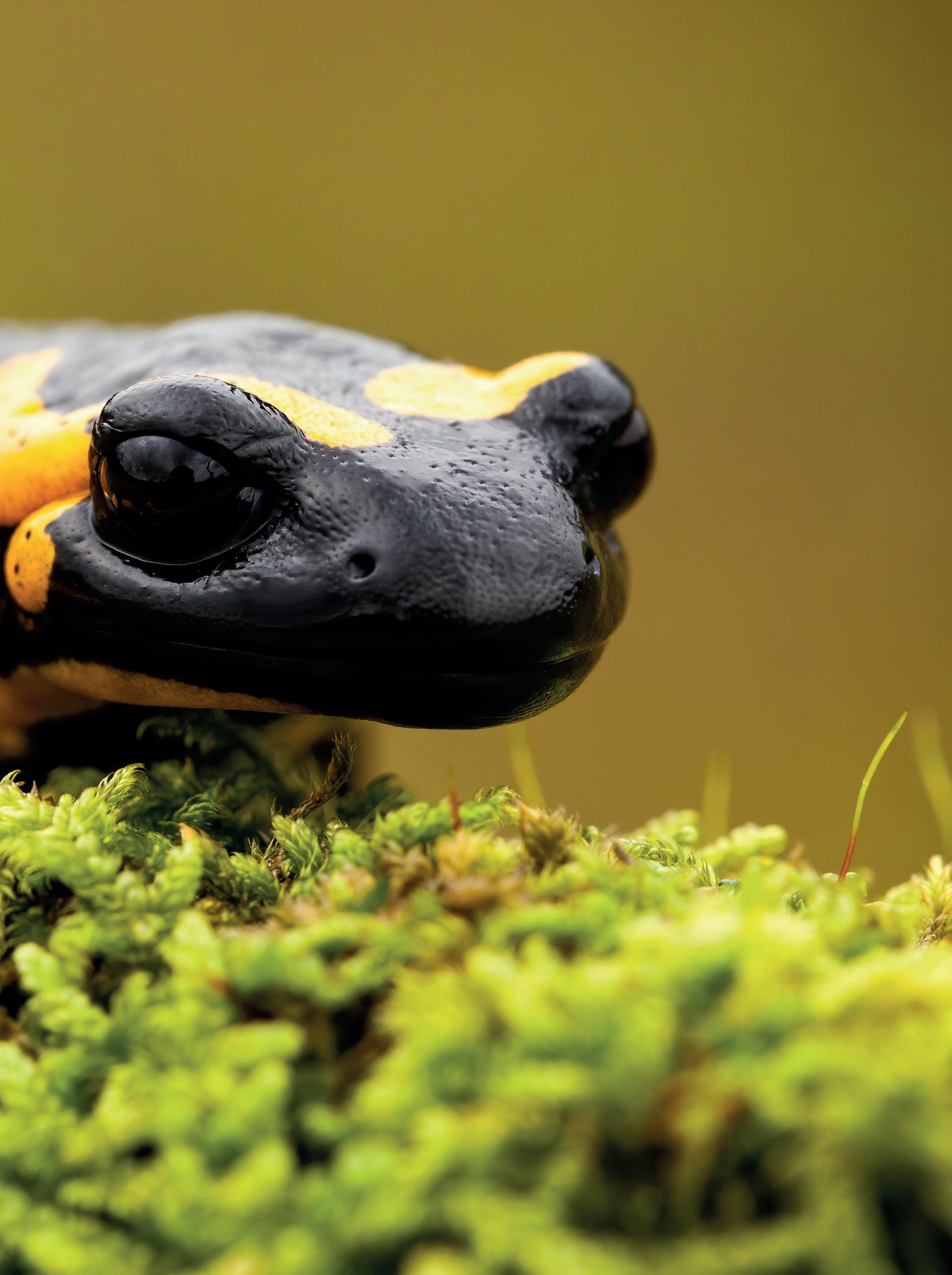 Fire salamander (Salamandra corsica)
Fire salamander (Salamandra corsica)
Shrouded in myths and folklore for their seemingly supernatural tendencies to emerge from the flames of bonfires, the natural history of fire salamanders reads like a medieval epic. Populations of this myth-shrouded amphibian were stranded upon mountain tops across Europe as the ice from the last ice age melted. This has created some of the most interesting cases of speciation and subspeciation seen within European herpetofauna.
With such a rich tapestry of morphologically and phylogenetically distinct species and subspecies across the continent and well into neighbouring Russia and Africa, understanding the evolutionary history of fire salamanders is particularly interesting. Being temperate amphibians that thrive in cooler climates, populations were isolated following the end of the last ice age. Once a widespread species, as the climate changed and habitats became less hospitable for these salamanders, individual populations were isolated at high altitudes where the climate is cooler. This is particularly apparent in the various species that are found throughout Spain, Portugal and the Middle East. In the warmer climates, each mountain range can be populated by an entirely new species.
The breeding habits of these salamanders also varies greatly depending on the conditions in which they are reproducing. Salamanders that are exposed to temporary pools of water, such as in warmer climates, will often produce fully formed terrestrial offspring. Those from cooler climates with reliable water sources will birth their tadpoles much earlier, allowing them to metamorphose on their own. This is
because the eggs are incubated within the mother’s body until it is time for them to hatch. Larger bodied females can also carry more eggs, for a longer period of time, also assisting in the speciation of fire salamanders. There are also populations that exhibit both breeding strategies and individual females have been know to produce tadpoles and fullyformed young in different years.
SALAMANDRA SALAMANDRA TERRESTRIS
This species is found across a huge area of France, Germany and Belgium, that includes the Rhone valley and Loire valley. Interestingly, these two populations have distinct morphological differences. The individuals from the Rhone valley are generally more robust animals with a heavier build. This species is sometimes called the ‘barred’ fire salamander and has a ‘Solling’ form which is one of the most sought-after of all fire salamanders and can exhibit tri-colour patterns. This form metamorphoses with red patterns that later turn yellow or remain red as the individual grows.
SALAMANDRA
SALAMANDRA FASTUOSA
This subspecies is a small to medium sized salamander that can be found across the French and Spanish Pyrenees mountains. Sometimes referred to as the ‘striped’ fire salamander, they typically exhibit pure and clean stripes that extend the entire length of the torso. They will produce mostly tadpoles but have been known to birth fully formed young too.

SALAMANDRA
SALAMANDRA BEJARAE
Initially thought to be spread across the entirety of Spain, distribution has been chipped down as new subspecies have been described. Bejarae is a moderately large species. Markings generally don’t follow a particular pattern, they can be blotches of yellow in various shapes as opposed to the more common spots or stripes observed in other subspecies.
SALAMANDRA
SALAMANDRA MORENICA
Occurs across the Sierra Marina in South Central Spain. Their distribution is a long narrow strip that follows the mountain range. It is highly possible that the two extremes of the range may produce even more subspecies that are yet to be described to science. Once considered bejarae Beautiful large growing salamander that produces tadpoles.
SALAMANDRA
SALAMANDRA GIGLIOLII
An extremely variable subspecies, gigliolii can be almost entirely yellow, giving it a stunning appearance. Found throughout Italy, the southern populations tend to have the brightest markings and colouration. Southern populations are very often entirely yellow. Locally, they are extremely abundant. In fact, being from an area that experiences long droughts, seasonal rains can bring these salamanders out on mass creating quite the spectacle for the amphibian enthusiast.
Adolescent salamanders are referred to in many ways. Although scientific literature generally refers to them as ‘larvae’, it is commonplace for breeders and educational materials to use the more colloquial term of ‘tadpole’.
Salamanders play a huge role in the maintenance and preservation of the world’s forests. Across Europe and the Americas, it has been proven that by feeding on insects and molluscs, salamanders help preserve leaflitter which slows the release of carbon. Salamanders are some of the most common woodland vertebrate species in North America, meaning despite having cryptic behaviours, they have an immense ecological impact.
SALAMANDRA SALAMANDRA SALAMANDRA
The nominate form of the fire salamander is extremely widespread from East Europe right into Russia. It is a robust animal and exceptionally hardy. With such a wide distribution, it is highly likely that there will be plenty more subspecies to be identified from this animal.
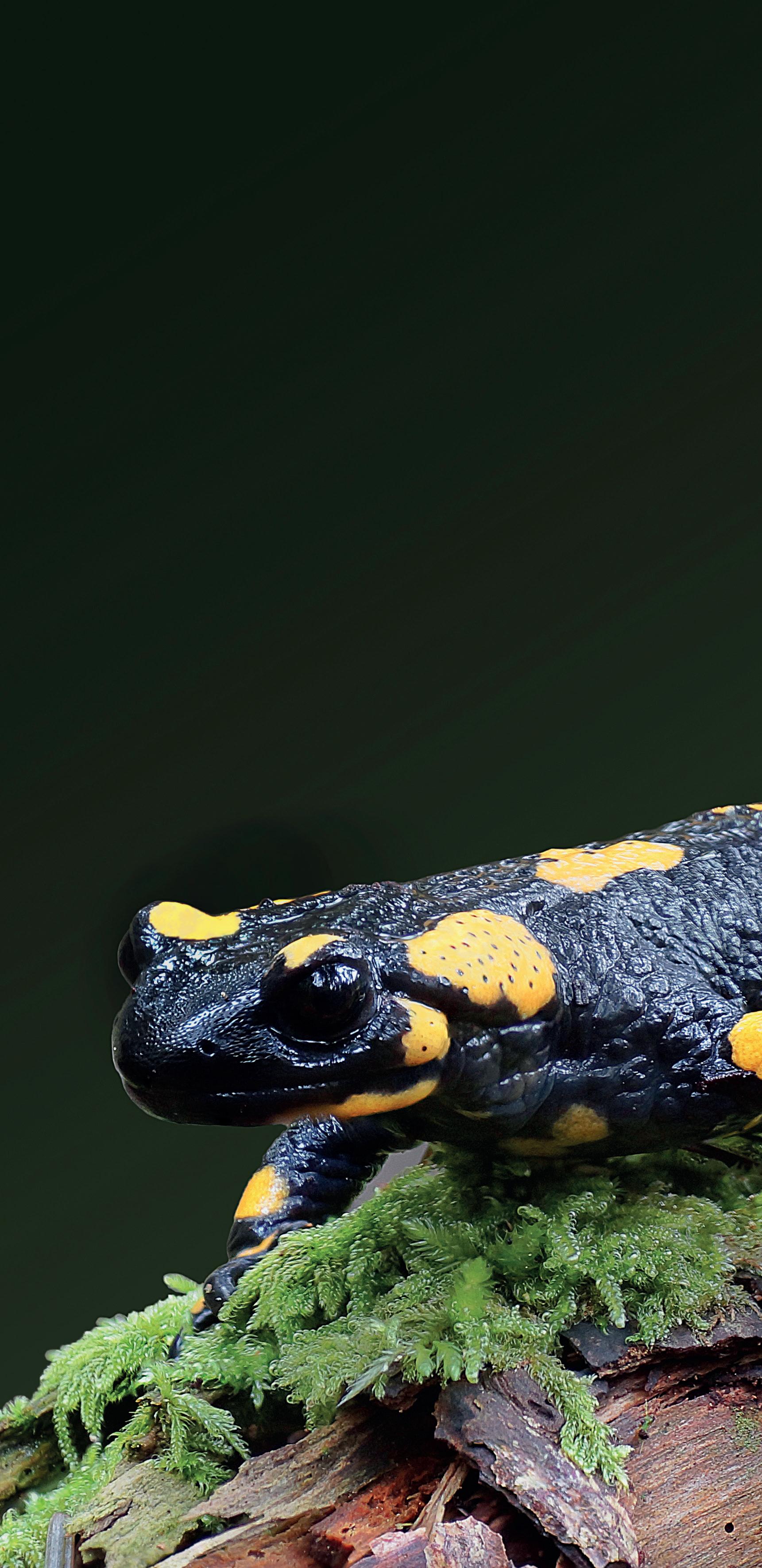
SALAMANDRA SALAMANDRA BESCHKOVI
A large robust salamander recently separated from the nominate subspecies Salamandra. Eastern European/ German subspecies. Medium sized and moderately marked with yellow.
SALAMANDRA SALAMANDRA GALLAICA
The Galician fire salamander is extremely variable in its appearance. Individuals can show colours from a mushroom brown all the way through to bright yellows and crimson reds. This species is found in Portugal and adjacent Spain. They are generally a large species that gives birth to large clutches of tadpoles. It often has markings around the head and glands.

SALAMANDRA
SALAMANDRA CRESPOI
Crespoi is one of the first of the new wave of newly described subspecies, following the work of taxonomists using DNA analysis. This subspecies is from the Algarve in Portugal and centered around the mountain of Monchique and found at high altitudes. This mountain is the highest point in the Algarve, making it a very isolated population. This eventually differentiated the subspecies from gallaica in the early 1990s.
SALAMANDRA
SALAMANDRA BERNARDEZI
Small growing subspecies, occurs in northern spain. Mostly terrestrial young. These animals are very variable in colour from completely melanistic to completely yellow with every combination in between. This species produces fully terrestrial offspring as an adaptation to a particularly hostile environment for depositing tadpoles.
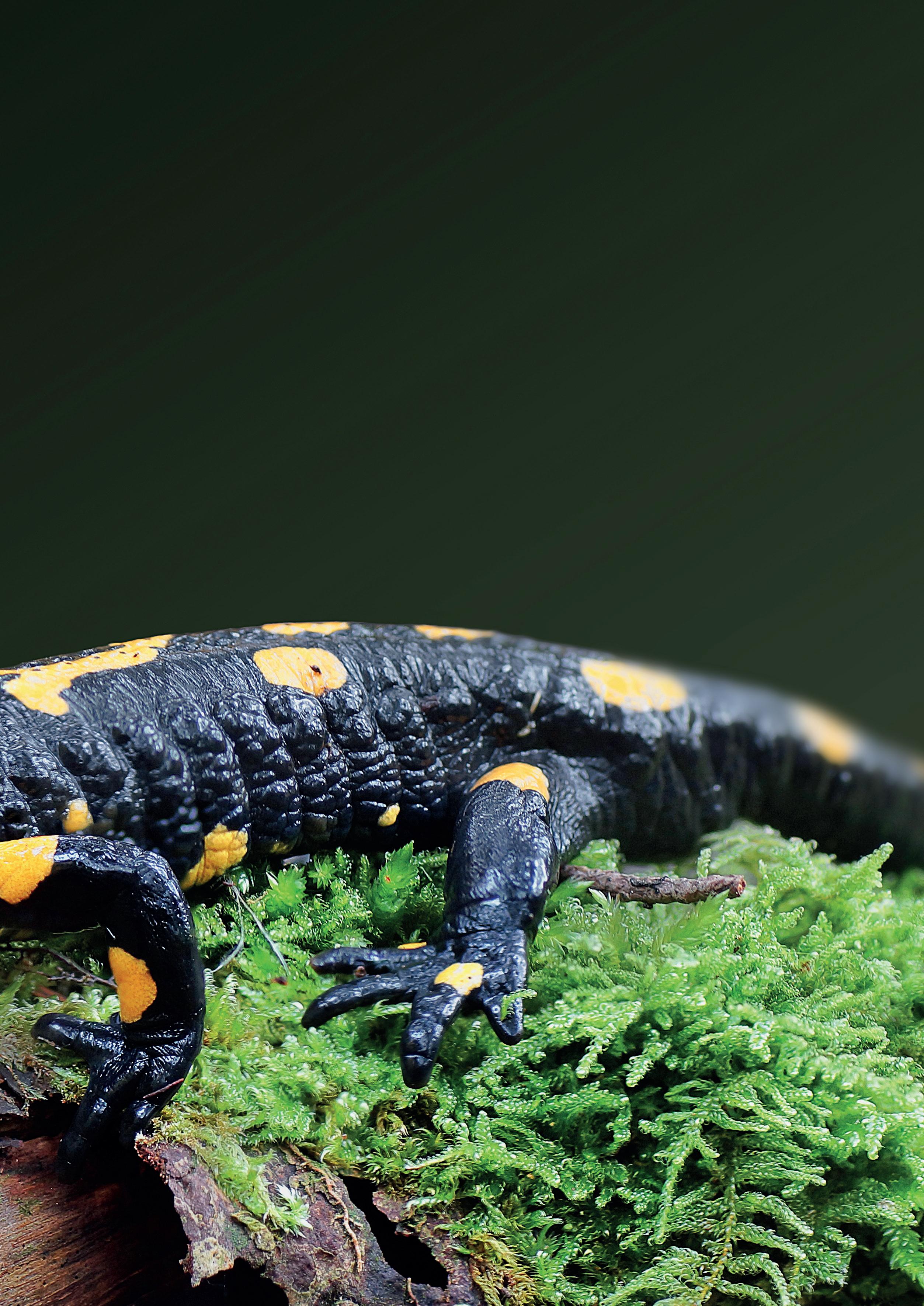
SALAMANDRA
SALAMANDRA ALFREDSHMIDTI
Alfredshmidti was broken off from bernardezi in the 90s, although opinion differs as to whether they are really distinct subspecies. They are found in the mountain ranges of Northern Spain and ‘all-yellow’ forms are extremely common. This subspecies regularly produces fully terrestrial young.
SALAMANDRA
SALAMANDRA ALMANZORIS
This population is centred around the few lakes in central Spain. When it was first described, it was described as an aquatic form. Of course, this is not true, but it does spend much more time in shallow water than other subspecies. Interestingly, these are mostly black with small white markings. Unsurprisingly, this species produces only tadpoles.
This species is a robust and heavily built salamander. As the name suggests, this species is only found on the French island of Corsica. Its head is wider than it is long and exhibits a range of bright yellow patterns. This was one of the first to be described as its own species following a lengthy DNA analysis process by Sebastian Steinfartz that took many years.
This moderately large species is sometimes referred to as the long-snouted salamander and occurs in southern Spain. Here, it lives exclusively in limestone-rich areas where it is entirely terrestrial and often bathes in water. This species has proven to be a real challenge for keepers, not coping very well in captivity. Those that have succeeded have provided UVB and high levels of calcium. Thus, it is theorised (and not yet scientifically proven) that this species has poor ability to absorb calcium, as the waters in its native range already contains exceptionally high levels of calcium.
As the name suggests, this species is found in Northern Africa and has recently been divided into two subspecies S. algira splendens and S. algira tingitana. Both species are found high in the Atlas mountains where the climate is much cooler. Tingitana are dark in colouration, almost entirely black but with bright yellow markings on the head and granular glands. Interestingly, this species also almost always gives birth to fully formed young. Splendens on the other hand, is much longer and slender and has
tadpoles.
This species is broken into three separate subspecies, all of which are from West Asia, Turkey and Syria. These are some of the largest fire salamanders with the nominate form (S. infraimmaculata infraimmaculata) being the largest of all. In fact, this species grows over 30cm in length and is the most southernly occurring species. It has even been reported that S. infraimmaculata infraimmaculata can birth up to 200 tadpoles per clutch, although 100+ is much more common. At almost 1/3 larger than most fire salamanders and coming from a harsh environment, this maverick survival technique makes complete sense. However, with rising temperatures, the survival rate of this species is dwindling as many of the waterways they deposit tadpoles in will dry up most years, giving them a breeding success rate of just once every 3-5 years.

S. infraimmaculata orientalis is another subspecies which has yellow blotches across the entirety of its body. Finally, S. infraimmaculata semenovi has very fine, reticulated yellow markings. This subspecies also has large clutches but its validity as an individual subspecies has been questioned.

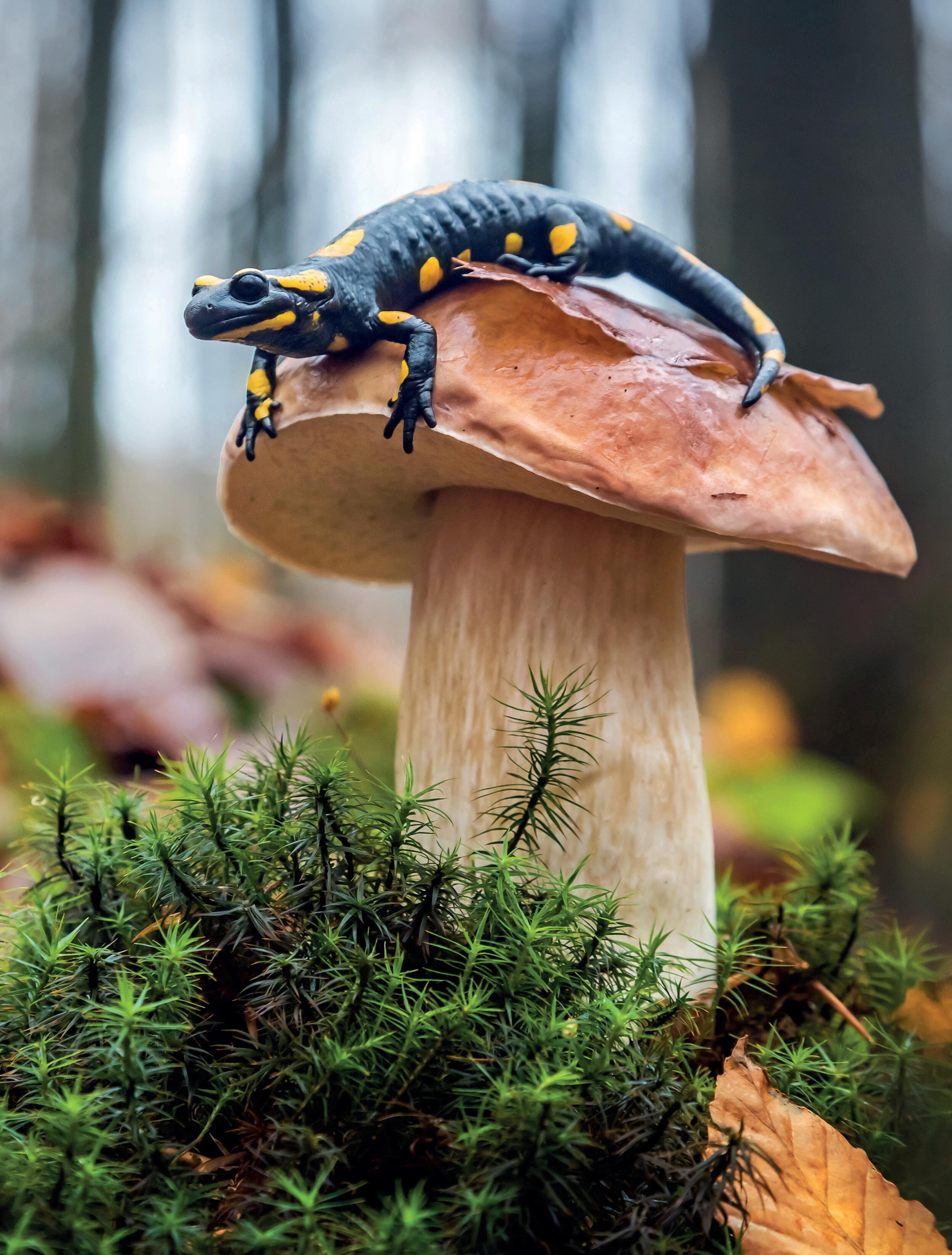
The Psittacus range features over 50 distinct products which are widely regarded as the best on the market.





















Not all parrot food is created equal.
reason. Just like the USA’s tiger salamanders (Ambystoma sp.), they require very little maintenance, have stunning patterns and have developed natural fascinations from enthusiasts all over the continent. In Europe, almost all species and subspecies of fire salamander are available and have been kept for generations, however here in the UK that spectrum is narrowed slightly.
Behaviourally, fire salamanders are quite cryptic, opting to stay hidden throughout most of the day. In the wild many populations remain deep in refuges for many months at a time to avoid heat and dry conditions. As well as having toxic secretions and delicate skin, their choice to remain hidden most the time makes them terrible pets for anyone expecting to keep an animal that they can observe or interact with. Amphibians should generally be kept away from children due to their delicate nature, but this is even more prevalent with salamanders that may resemble a friendly lizard to a curious child.
Nonetheless, their hardy nature and temperate requirements makes them a brilliant animal to keep both indoors or outdoors in the UK. Furthermore, the recent restrictions on importing salamanders make

them an interesting breeding project and one which is often very successful for first-time breeders. Their viviparous (in the case of fastuosa and bernardezi) and ovoviviparous birthing habits make them an extremely rewarding animal to work with.
Previously, the most popular way of keeping fire salamanders was in almost entirely sterile conditions, using paper towels as substrate and cork bark for hides. Interestingly, these animals did extremely well in captivity but the constant necessity of cleaning them out, as well as very little natural enrichment has shifted how most people keep these animals today.

Nowadays, a bioactive set up comprised of a natural soil-based substrate like Bio Life Forest, with a shallow water dish and various cork bark and slate hides is preferable. Substrate can vary from decomposing leaf litter, through to bark-based mixtures. However, this should never stick to the salamander. Dry coir or course bark and sand can stick to the salamander’s skin and cause dangerous levels of stress.
Creating a perfect fire salamander enclosure is quite straightforward. Aside from the obvious minimum enclosure size requirements which will vary between species, all fire salamanders are cared for in a similar way.
These salamanders will thrive in a very basic indoor RUB set up, an elaborate bioactive terrarium or even outdoor enclosures, semioutdoor enclosures, and greenhouses.
Of course, outdoor set ups will require a good understanding of species-specific requirements and biosecurity measures, but indoor set ups follow a similar structure.
will typically live at higher altitudes and thus cooler temperatures. Therefore, trying to adapt our husbandry to the country of origin of a species, is often ill-advised and a complete guess without scientific research to back up our decisions. That being said, those choosing to house their salamanders outdoors should choose a Northernly species that is typically more resilient to the harsher winters we experience in Western Europe.


Fire salamanders can be kept extremely successfully outdoors. In fact, it’s very possible to create the perfect enclosure for many of the Northernly species and can be a wonderful feature in the garden. However, there are some crucial considerations to make.
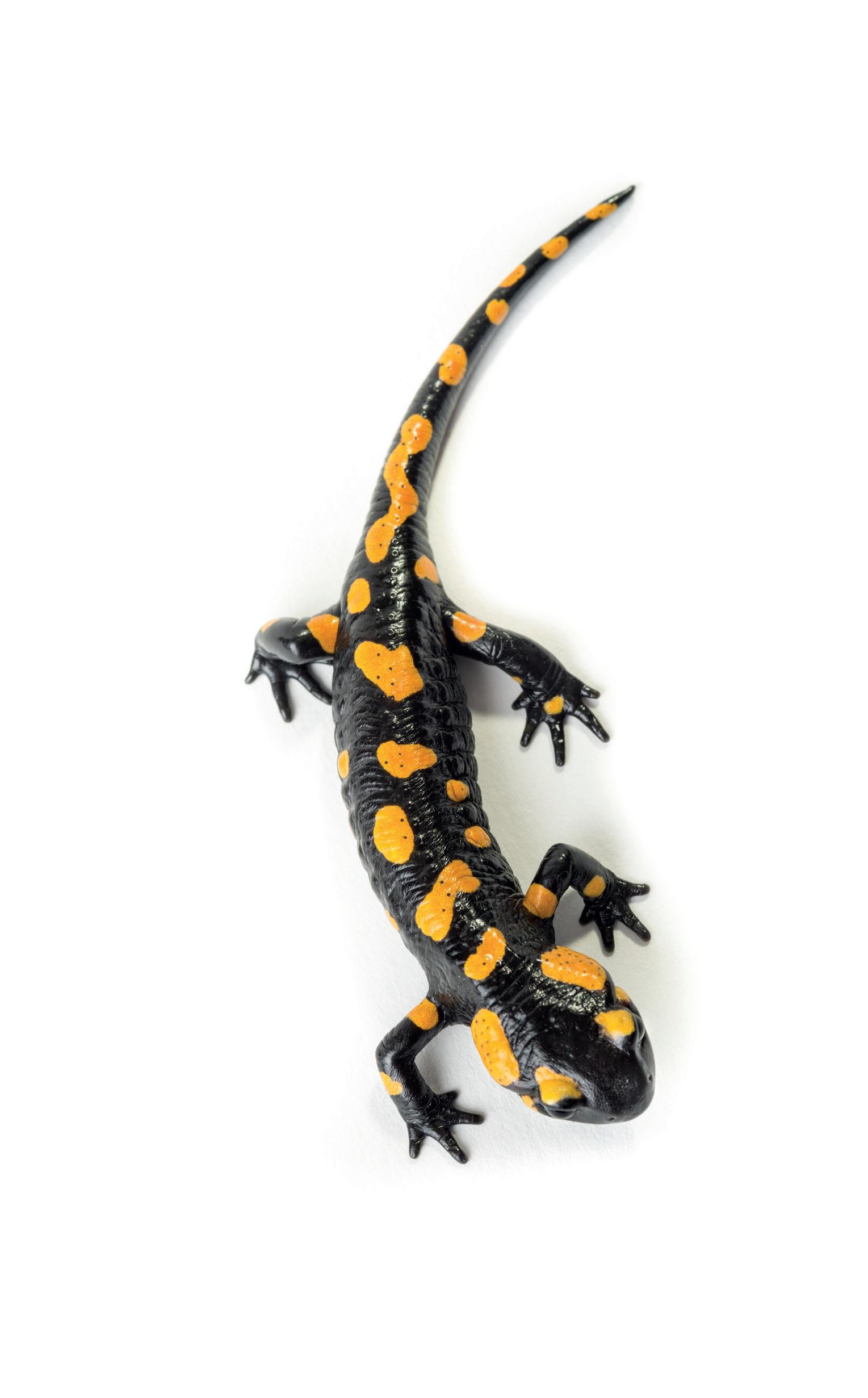
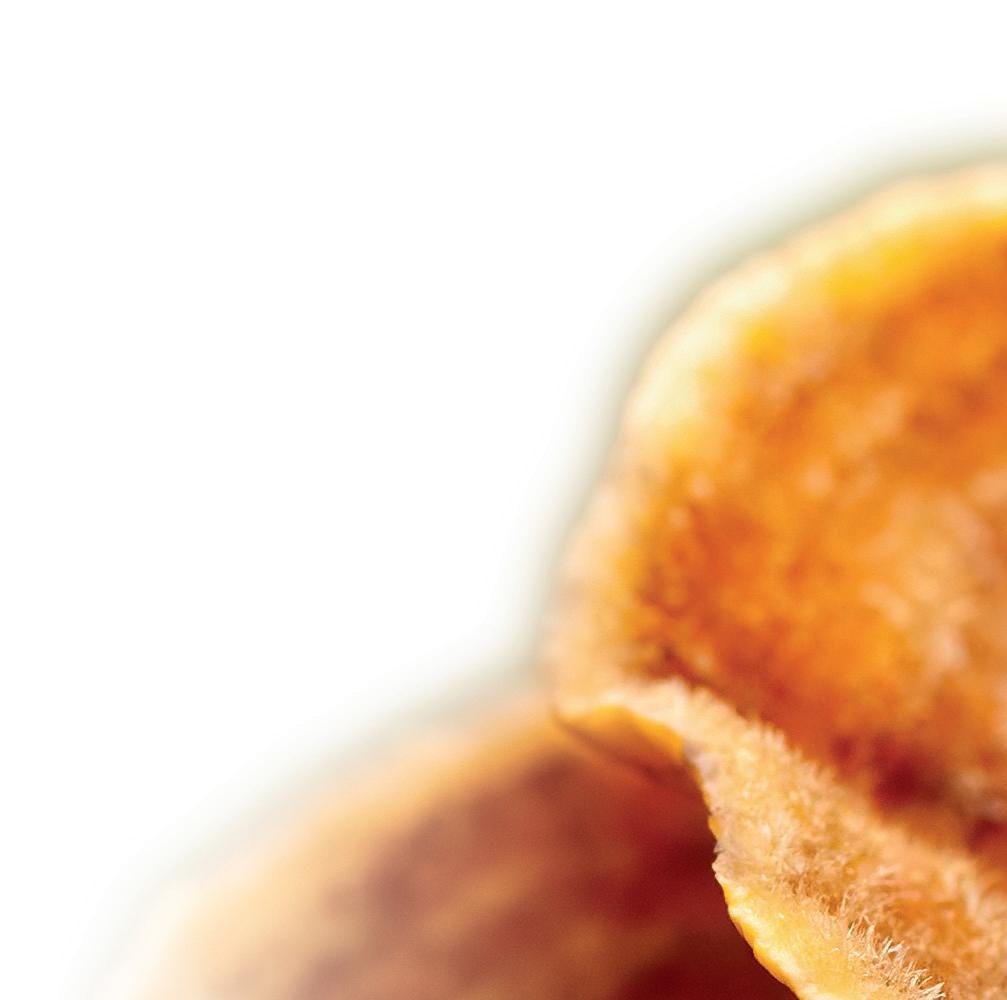

Firstly, the salamanders will rarely be seen. In fact, the only time you’re likely to see the animals is at night, after rain, with a torch. While this is the most natural way of observing the animals, it does mean that opportunities to watch the animals are limited. Furthermore, the keeper will lose a significant amount of control with outdoor vivaria. Meaning if a problem occurs with the animal, it is often too late to resolve by the time the keeper identifies it.
Secondly is security. Not only should the keeper be cautious about birds and predators getting into the enclosure, but with the rise of Bsal, the keeper should also make sure that biosecurity measures are taken to prevent animals or tadpoles from escaping. Fences should be dug deep into the soil or dedicated outdoor vivaria should have at least 5 inches of soil around the bottom and sides of the enclosures. Water must not contaminate nearby rivers and streams, as the pathogens that carry this disease are easily spread. Finally, wild-caught specimens are now banned from entering the UK. Although this means your animal will almost certainly be captive bred, make sure you are 100% sure of this and implement a quarantine procedure if it has come from a larger collection.
Aside from these two points, outdoor keeping is extremely straightforward. Keepers can get great enjoyment from planting ferns and mosses, creating rock walls and water features etc to create the ideal habitat. Species such as S. Salamandra S. Salamandra bernadazi and S. Salamandra fastuosa will thrive outdoors, providing they are given a frost-free area to shelter during the coolest months. This can be achieved by creating a polystyrene shelter and filling it with moss and cork bark then burying it into the ground. As long as the
entrance point is small enough to avoid a frost, but large enough to allow the salamander to access the hide, the enclosure should be suitable all year round. In the unlikely event that frosts persist, with a long period of -5°C or below, the keeper should consider bringing the animals inside to shelter them from unnecessary extremes.
Fire salamanders are insectivorous, eating mostly soft bodied inverts such as worms, snails and slugs. However, they will also eat crickets which can be quite surprising given their slow-paced characteristics. Providing a wide variety of live foods will give them the best diet but more crucially, ensuring that every feeder insect is gut loaded and dusted to reach a good nutritional profile is absolutely paramount.
Fire salamanders are particularly susceptible to metabolic bone disease. The first instances





are often seen when the salamanders back legs become weak or spinal kinks become apparent. At this point, it has been noted that with the correct medical intervention (providing high quality nutrients etc) people have managed to save their salamander. However, it is much more common that identifying the first symptoms of MBD is a precursor to a premature death.
Because fire salamanders are such stocky animals, they are required to build big skeletons and thus have huge calcium requirements. Using a balanced vitamin and mineral supplement such as Nutrobal, whilst gut-loading feeders on a high-quality formula, will prevent medical issues.

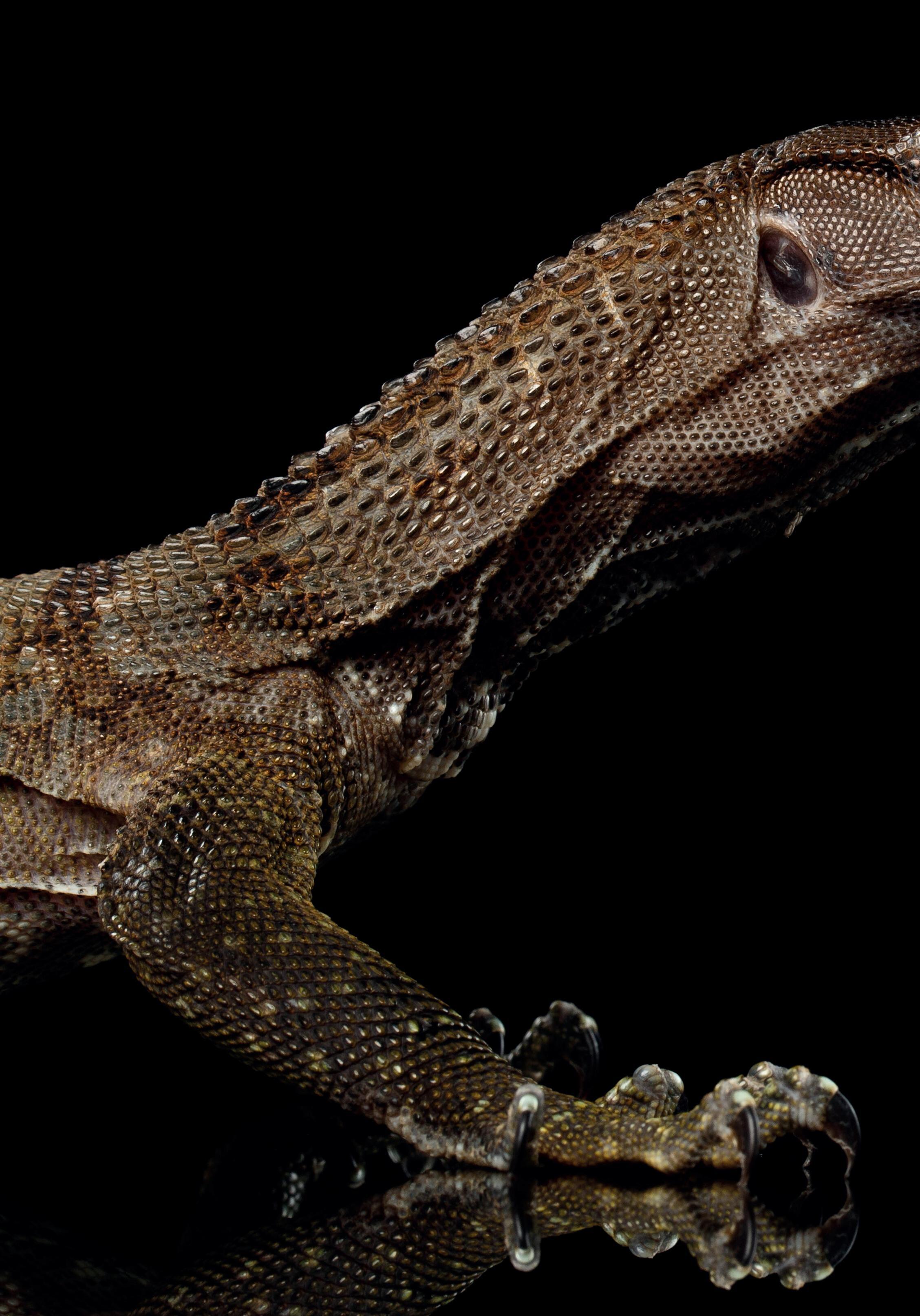 Rough-necked monitor (Varanus rudicollis)
Rough-necked monitor (Varanus rudicollis)
Rough-necked monitors bred in captivity in suspected UK first.
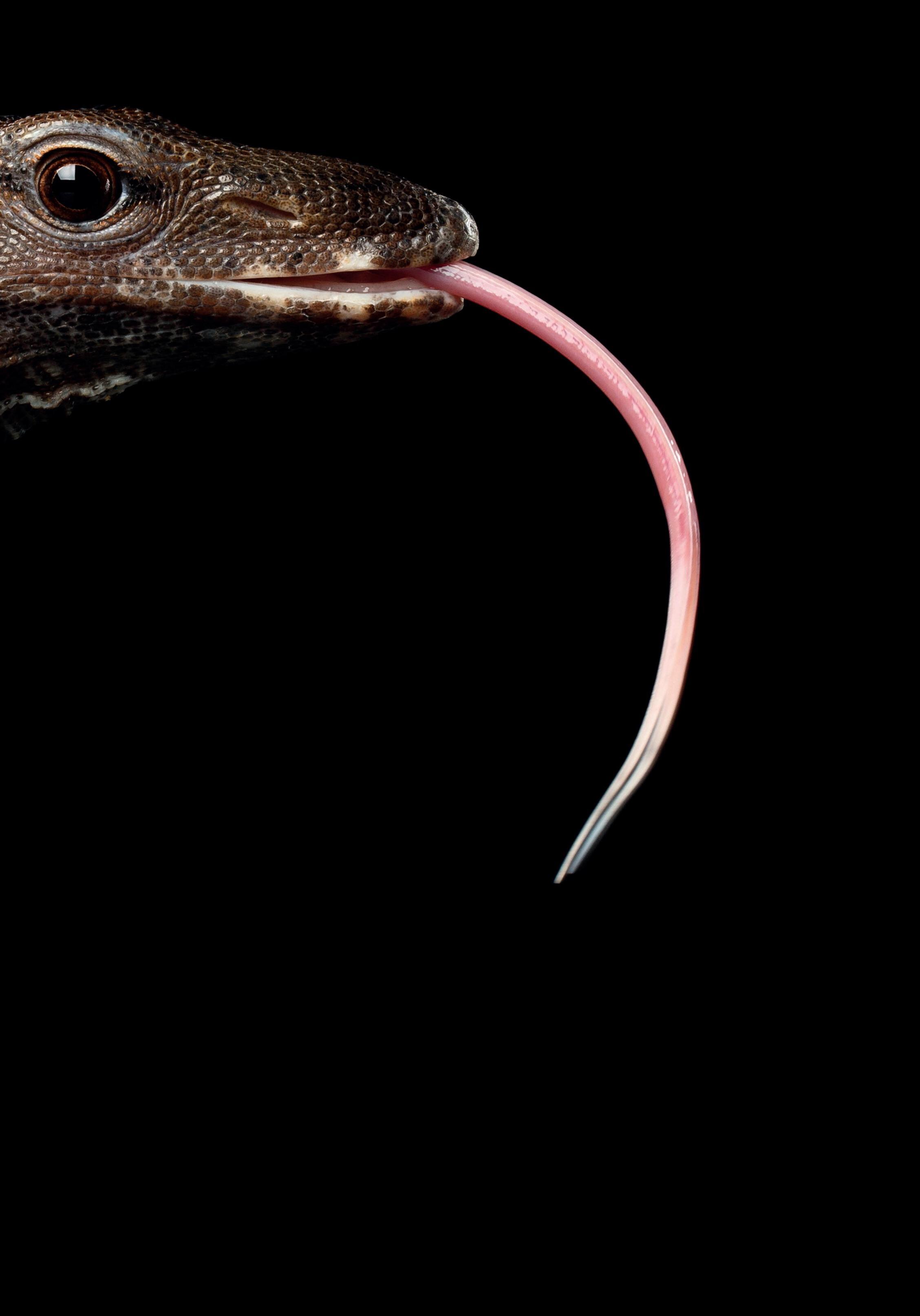
Rough-necked monitors (Varanus rudicollis) are an extremely secretive and cryptic species from Southeast Asia. Although they are frequently kept in the USA and some individuals have been kept in the UK, captive-bred individuals are almost unheard of. As with all species, a healthy captive-bred population is considered the main goal for enthusiasts who aim to meet the demands of hobbyists, without further impacting wild populations. Therefore, the recent success of Branden Darlison-Hoskin and Anthony Walker-Manning in producing what is thought to be the UK’s first captive-bred rough necked monitors is cause for celebration and proves the dedication of private keepers in reaching significant milestones.
Branden told Exotics Keeper Magazine: “We’ve been wanting to tell the world about our project and great news, we have successfully bred what we think is the first captive bred roughneck monitor (Varanus rudicollis) in the UK.”
“Since a child I idolised Steve Irwin, much like many other herpers. I got my first reptile, which was a bearded dragon at age 10 and my passion for reptiles grew and grew. It was my dream to work with reptiles, so I went to college and studied animal care, then managed to get a job in a pet shop in Norfolk called Swallow Aquatics. When I was there, I had a customer bring in a young rough neck monitor and I fell in love with it. My good friend Ant, who’s also a fellow herper, fell in love with her too and we made it our dream to find another one and try to be the first to captive breed this species in the UK.”
Of course, large lizards can be extremely challenging animals to care for and prospective keepers should seriously consider whether they have the right facilities to embark on such a project. Luckily, Anthony had been keeping reptiles for 30+ years, initially starting with a green iguana in the 90s. As a cabinet maker by trade, Anthony was skilled enough to build large zoological-standard enclosures to house the lizards. This experience allowed him to create a 10 X 8 X 4 feet enclosure for the rough-necked monitors, giving them ideal conditions to breed. Anthony’s partner, Emma Newman also supported the project by ensuring regimented feeding and general upkeep was met 24 hours a day.
Branden continued: “Luckily, we found a male specimen. They were both fairly young when we
first purchased them, so we needed a couple of years of getting them to good size and breeding weight, with a correct varied diet. As for acclimatising them for copulation, the only thing that we changed was the light cycle. It was adjusted to mimic our outside light. For example, in winter as it got darker, we set their lights to go off earlier. Looking at the light cycles in South East Asia they tend to get around 11.30 hrs of daylight during the our cooler months and 12.45 hrs during our summers, We also have microclimates that set day and night temperatures. So, at 07.30 am its set to 45°C and at 19.30pm its set to 25°C.”
After mimicking wild conditions for many years, to provide the most natural husbandry, it was time for Branden and Anthony to introduce the pair of monitors.

“We first had the adults in separate enclosures and used to open the cabinet door and let the female come out and make her way round the room. The first day the female was more interested in just looking round the room, however the second day we let her out, she walked straight up to the males tank and they sat looking at each other through the glass. The next day we let him out with her and after a short while they copulated and were in copulation for around 48 hours.”
We’ve always provided a varied diet and we did give more calcified foods to help with the development of the eggs. We provide them whole prey mince with insects, which is a blended prey such as rabbit or pheasant or chicken with the all the bones and insides and added insects, which is full of protein and calcium. They also had whole eggs including the shells, freshwater prawns and fish. The majority of this was dusted in a calcium powder to create good shells for the eggs without pulling too much calcium from the female when she was creating them.”

Captive breeding projects are generally the culmination of years of hard work and significant study. Not only does the private keeper gain a brilliant insight into the species, but the captivebred offspring can continue to allow students, zoos, conservationists, and other private keepers to gain similar offspring in the coming years. Of course, perfecting the formula has its challenges.
Branden continued: “One thing we learned is it was supposed to be very difficult to sex this species without ultrasound or x rays, however when mature you can quite clearly see the differences between the sexes. With males the base of his tail near his cloaca has a much larger bump or hemipenil bulge. Females on the other hand, are flat. I think the key is to just give them a large enclosure with plenty of branches to climb, deep soil to burrow, good UVB, a hot spot of 45.C and a nice, varied diet.”
“The biggest challenge we faced was the incubation of the eggs. We first tried to incubate in vermiculite and after 6 months the eggs died. When we cut them

December and obviously the house temperature with the heating coming on may have caused something to change, maybe there wasn’t enough humidity? We don’t actually know the exact reason! However, when we incubated the second clutch we changed the way we incubated them. We used perlite instead of vermiculite and we completely covered the eggs. We then sat the tub in another tub of water. We did not check the eggs until 10 days before hatch date (which was 200 days of not knowing if they were even fertile!). We then uncovered the eggs and put the lid back on. 24 hours before hatch date we took the lid off to allow the humidity to come in. Then they successfully hatched. I can only imagine that they hatch during the wet season in the wild.”
Both Branden and Anthony have lots of experience with a wealth of different exotic species. A selfconfessed green tree python lover, Branden also breeds electric blue day geckos (Lygodactylus williamsi) The duo has shares in other breeding projects for peach throat monitors (Varanus jobiensis), mossy geckos (Mnairogekko chahoua) and snakenecked turtles (Chelodina rugosa) to name a few.
“It’s been an emotional journey. Over a year ago, the first clutch of eggs were laid, the heartbreaking part was these were unfortunately lost. They were fully developed and yet did not hatch we were so close yet so far. 30 days after losing those, we put another
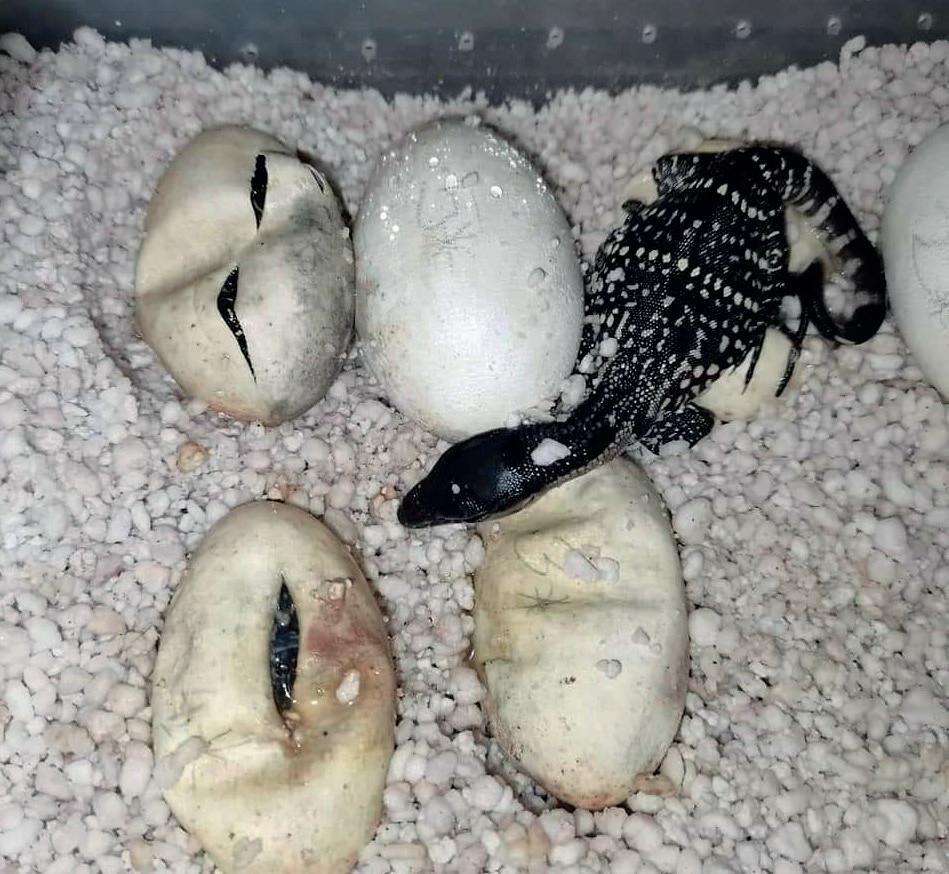
7 eggs into the incubator, they looked absolutely perfect. We were clinging onto every bit of hope and 200 long days later our dream came true, and our first egg pipped.”
“Three baby roughnecks emerged very healthy and lively. When they first hatched, like many reptiles, they came out with egg sacs. These took around 4-5 days to fully absorb. Surprisingly, it wasn’t until around the 18th day after hatching that the rough necks finally would feed on their own (a very scary time). However, we pursued with different food sources I.e boiled egg, locusts, roaches, crickets, mealworms, chopped up pinkies, snails etc, and just like that, after turning their noses up on everything and being more interested in exploring the enclosure, the baby roughlins started smashing food. Locusts seem to be their preferred food choice. They first hatched on 24th June. I’ve just weighed one today and it is 18.57 grams and 23cm
long from snout to end of the tail. Big monitors can be very shy creatures and powerful animals. It can take time for them to build trust with you. But, with the babies we can build that bond right from the egg.”
Successful captive breeding projects are a beneficial way to understand more about reptiles, particularly cryptic species. Whilst readers are always encouraged to keep captive-bred animals where possible, experts in both zoos and the private sector can contribute significantly to herpetology by keeping lesser-known species. Understanding our own limitations, potential challenges and desired outcomes from our animals is the first step towards being a responsible exotics keeper. With Branden and Anthony sharing their knowledge and maintaining genetic records, further successful captive breeding can reduce the number of wildcaught rough neck monitors in captivity.

IF YOU ENJOYED THIS MONTHS EDITION, WHY NOT SUBSCRIBE?
SAVE 20% OFF AN ANNUAL SUBSCRIPTION WITH CODE EK20


EXCLUSIVELY AT WWW.EXOTICSKEEPER.COM
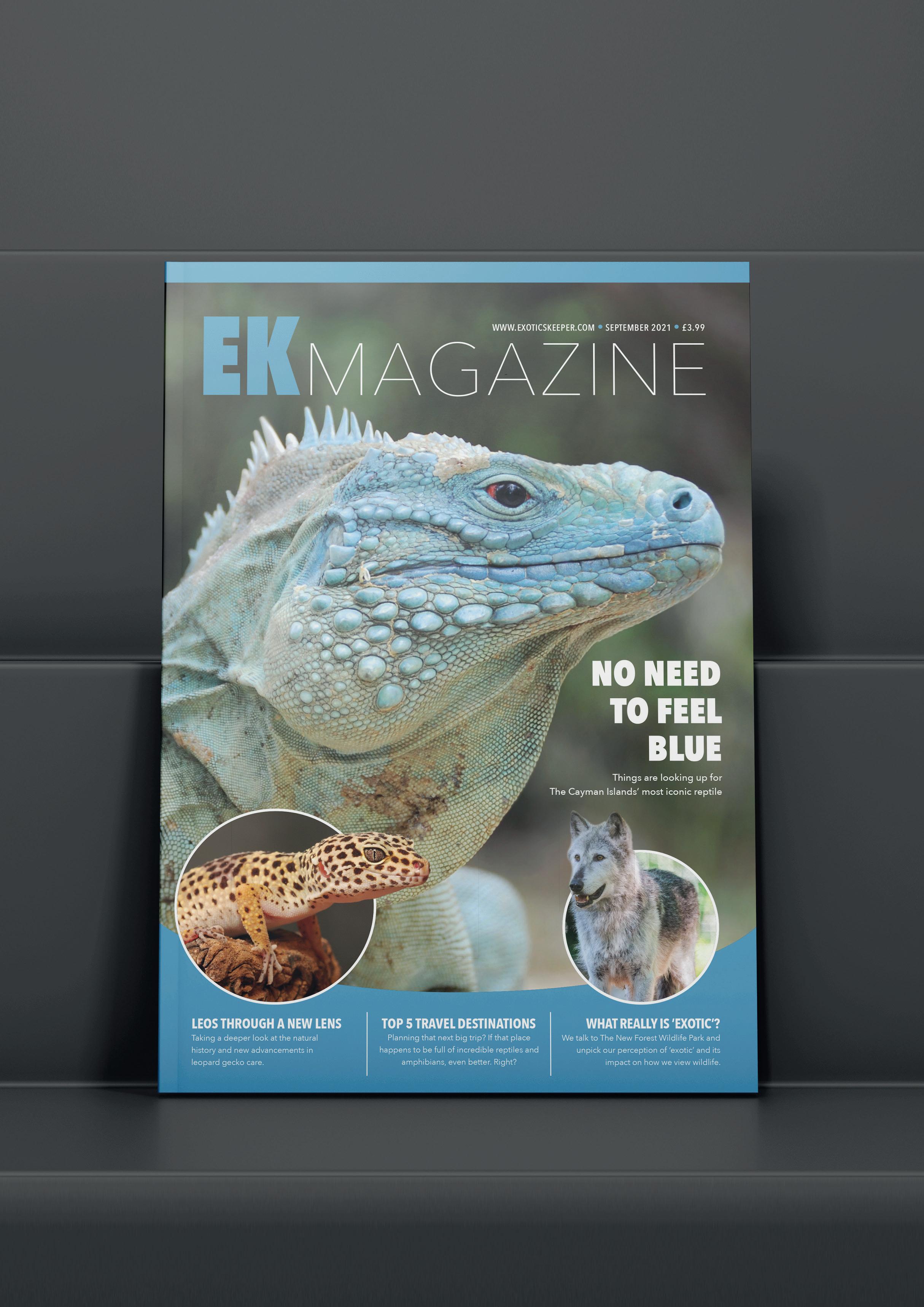
www.pro-rep.co.uk

Mixed Desert Substrate
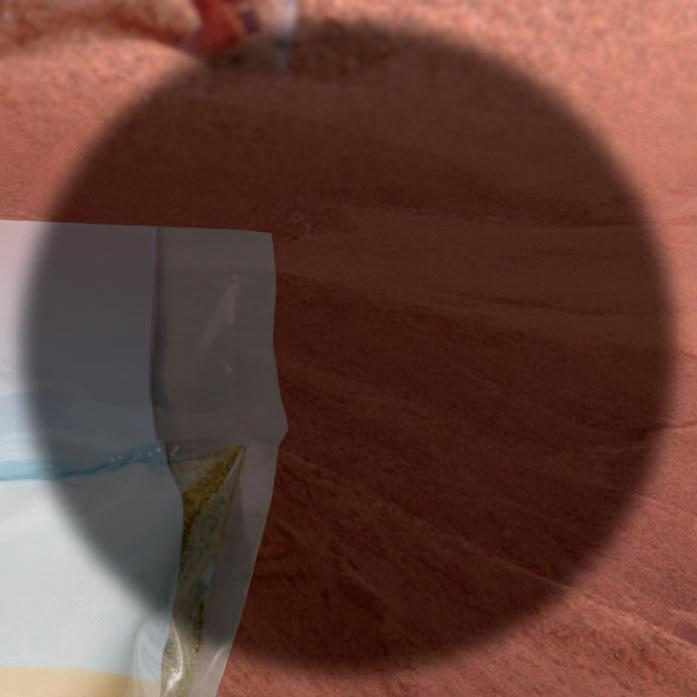





A blended substrate to help create the ideal environment for Leopard Geckos and other desert species.
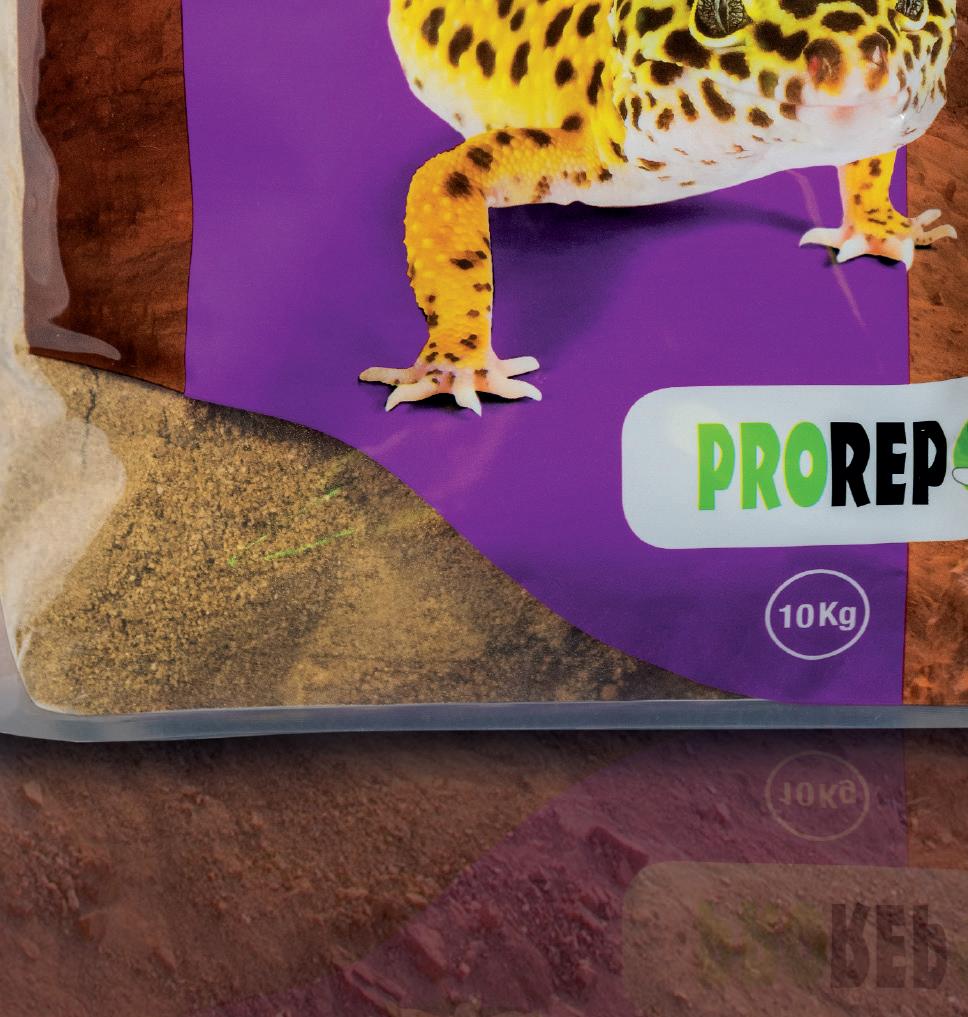
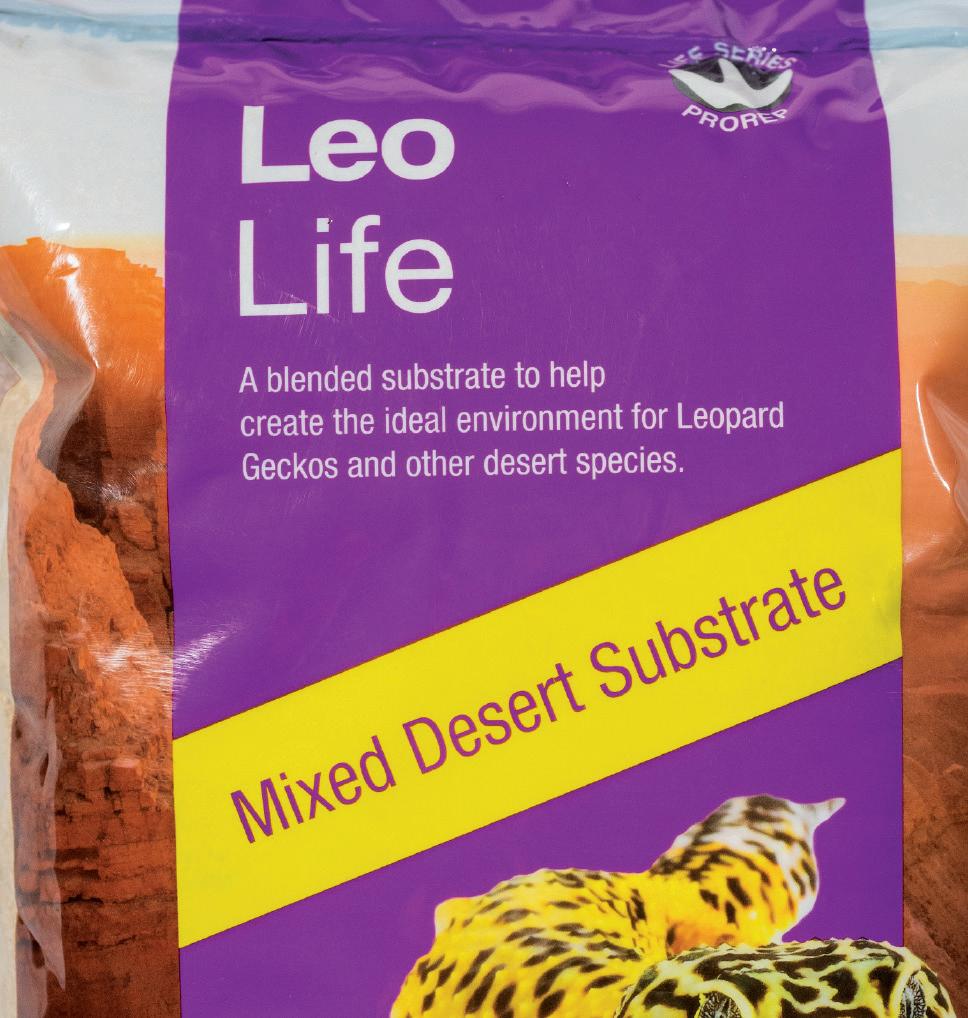

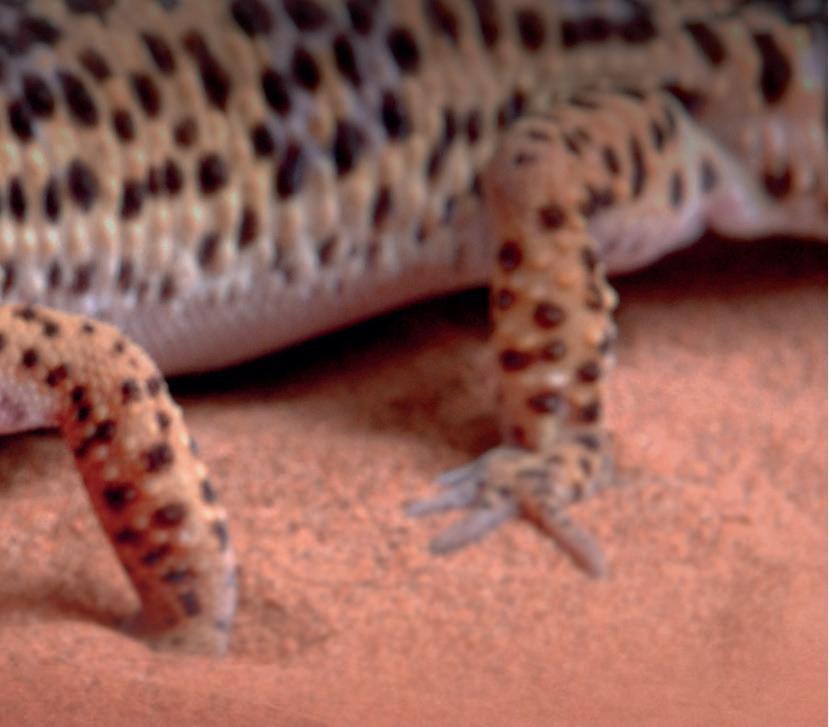
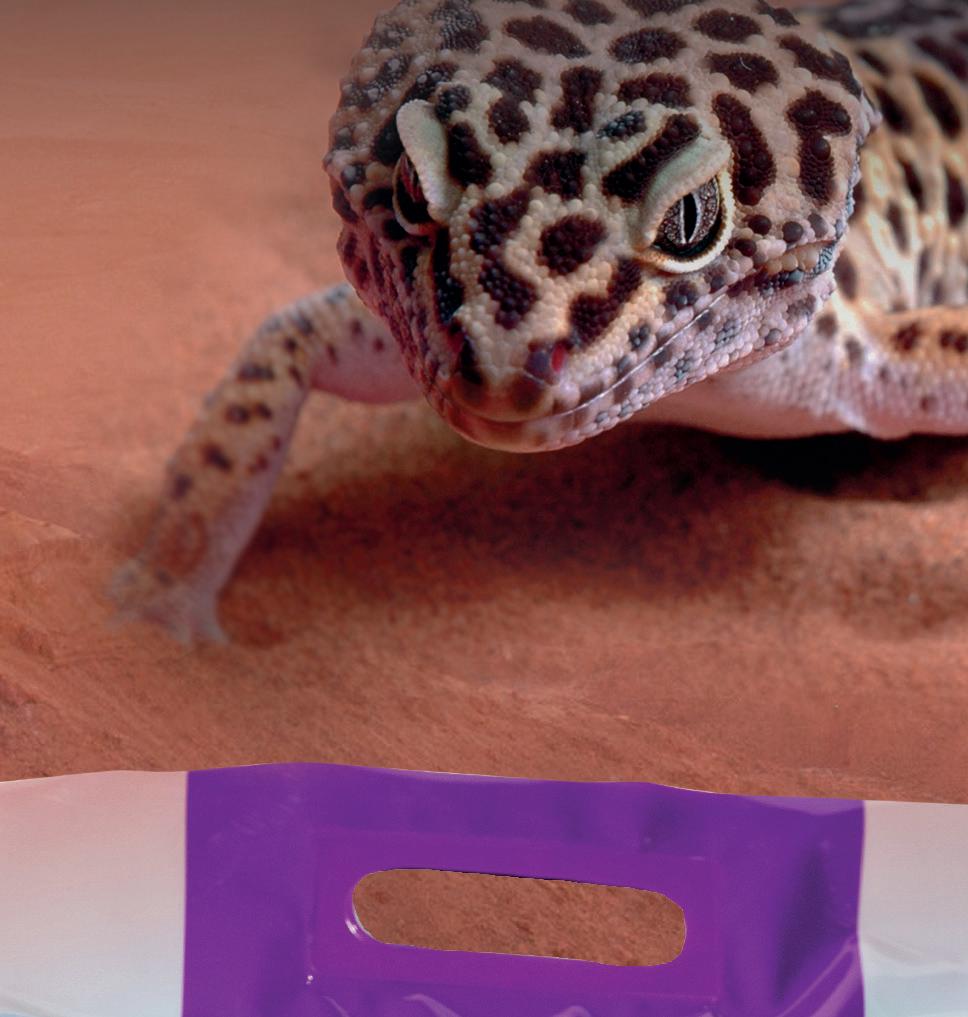



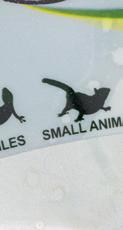
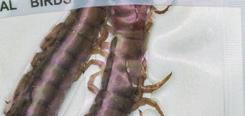

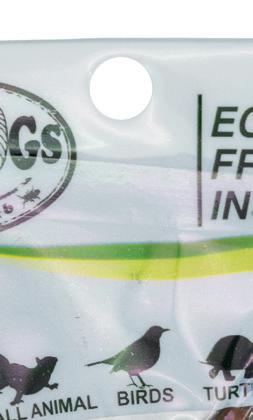




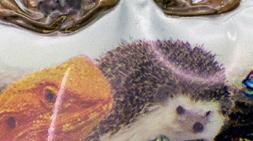










































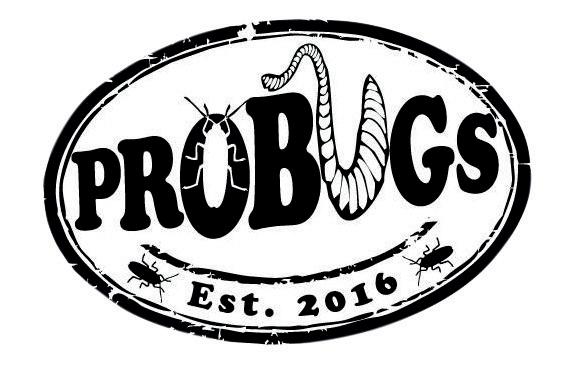



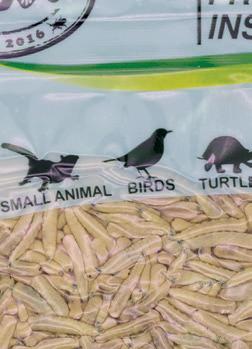
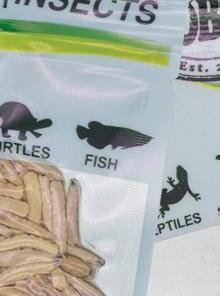



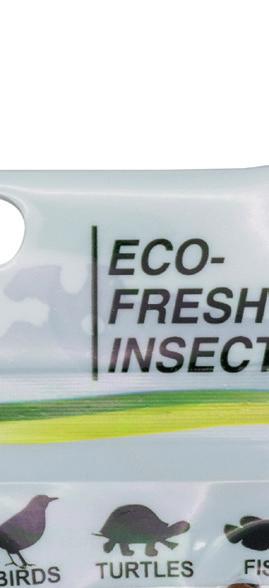

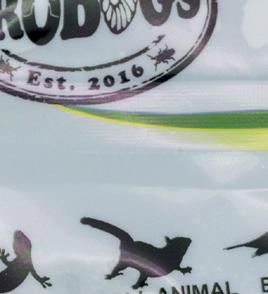

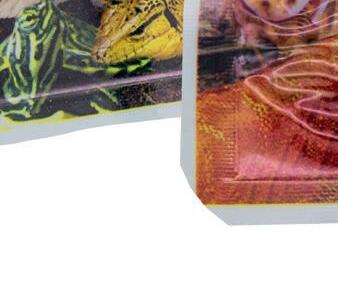

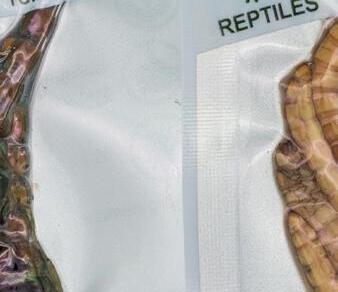
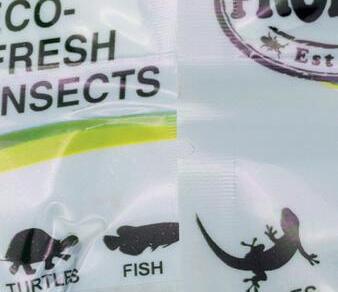






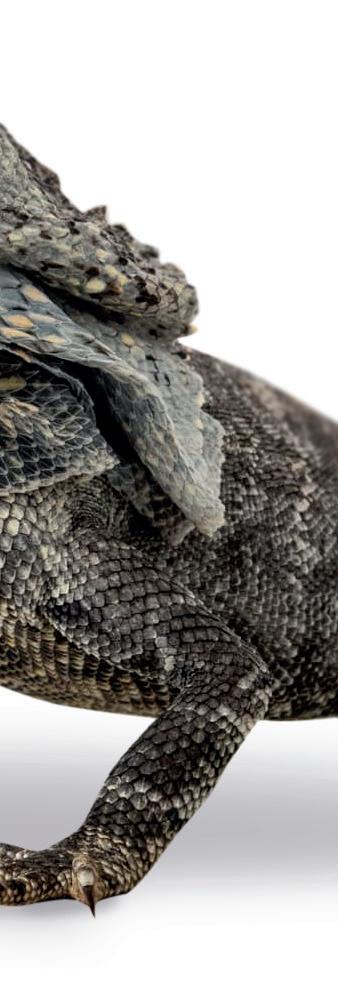



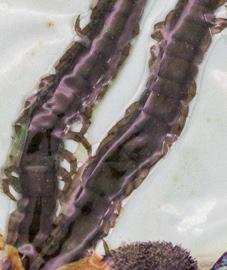


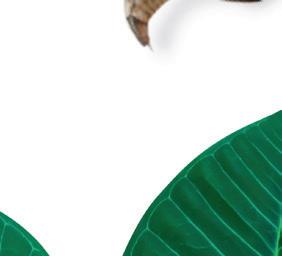




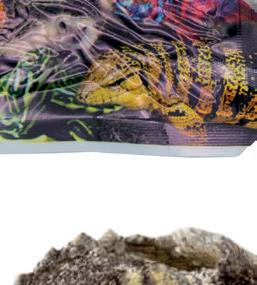



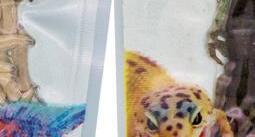

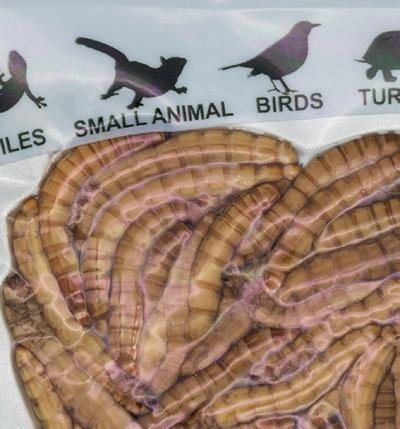
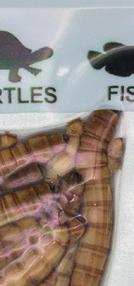

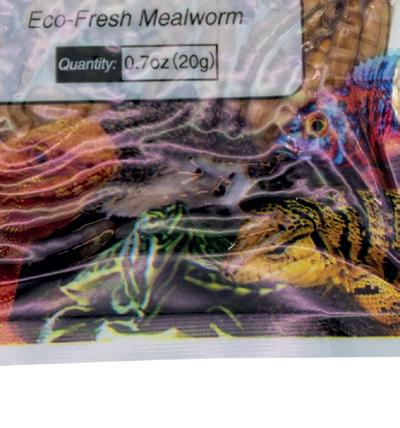
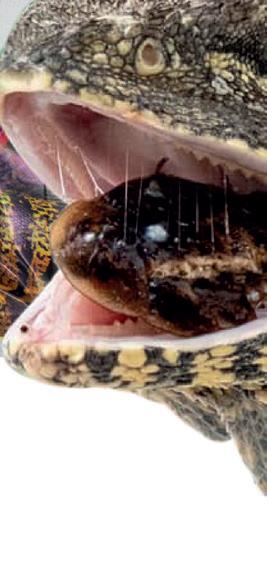


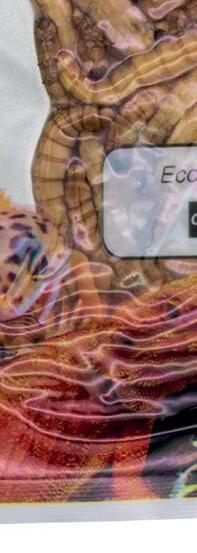
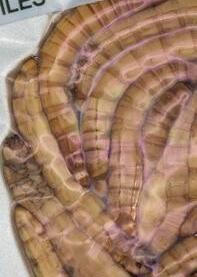

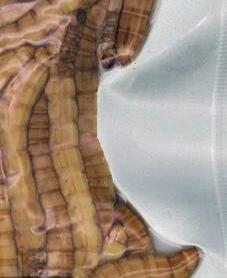

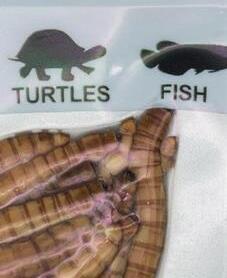















Astaple in the horror culture is the zombie trope, where usually a virus will infect living things and turn them into mindless, cannibalistic zombies. Fortunately, humanity has not been threatened in this way by an incurable virus, but a certain kind of fungus lurks in the invertebrate world with startlingly similar effects.
Cordyceps is a genus of fungus comprised of around 600 species. Most of them are known to be endo-parasites of invertebrates and arthropods. You can find Cordyceps species worldwide, but most often in humid, tropical, equatorial forests.
When the parasitic species attack an invertebrate host, the mycelium of the fungus begins to replace the host organism’s tissue. As it spreads, it slowly assumes control of the host by
overriding the muscles and limbs. Each species of cordyceps seems to specialise in a particular host. Ophiocordyceps unilateralis, for example, is known to target ants, sometimes successfully infecting entire colonies.
Cordyceps fungi inspired the zombie outbreak in the award-winning video game series The Last of Us, as well as the novel and film adaptation of The Girl with All the Gifts.
Near the end of the process, the fungus compels the host to seek a suitable position to disperse its spores, such as a high point on a branch. Once there, an ant for example will anchor itself in place with its mandibles while an ascocarp (sporebearding stalk) emerges from the hosts body, releasing cordyceps spores into the air, beginning the cycle again.
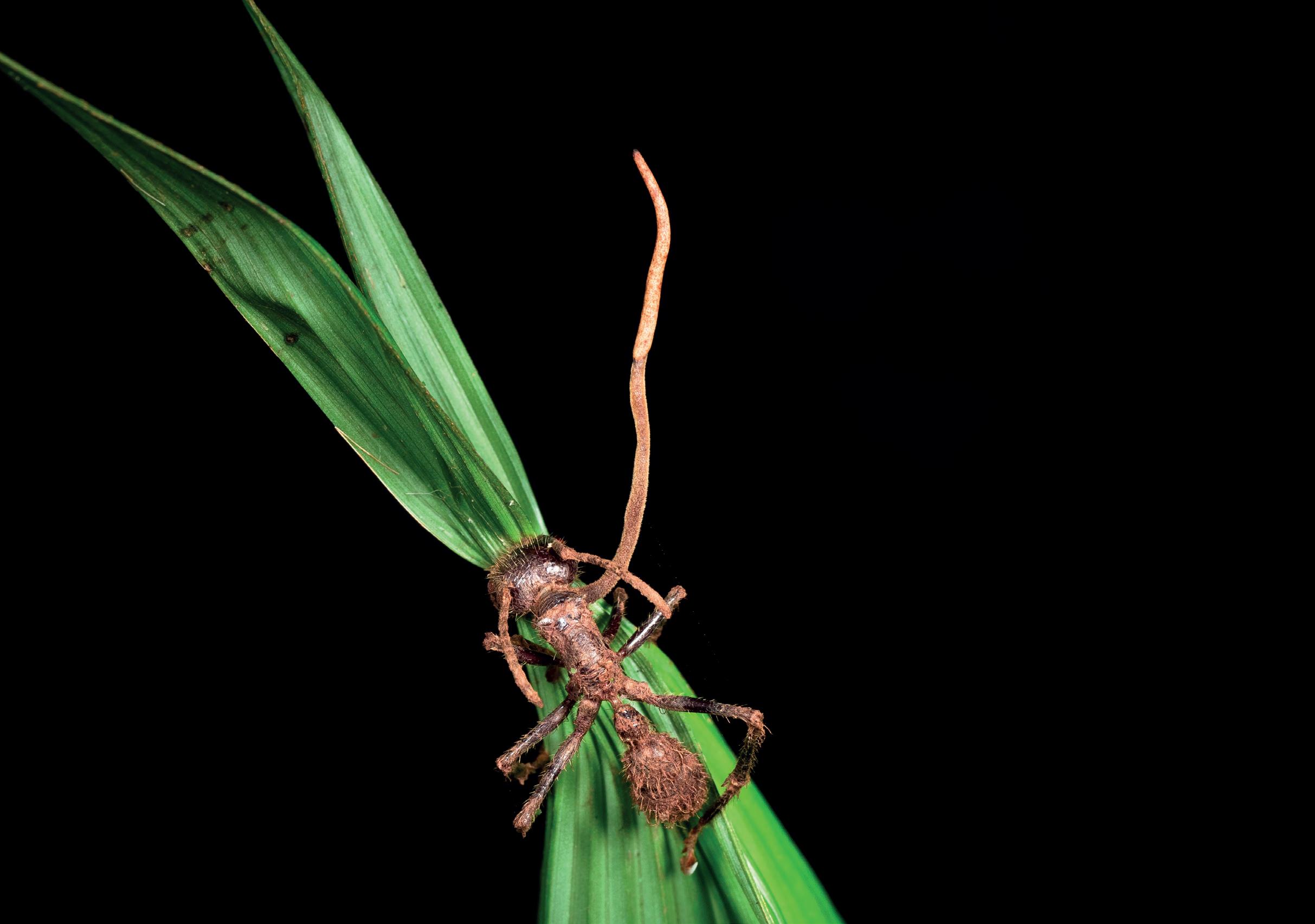
This is a horrifying demise by anyone’s standards. Fortunately, cordyceps are only known to infect insects (thus they are entomopathogenic), with a few infecting other fungi species. In fact, cordyceps have gained popularity as a potential health supplement.
A fossil of a prehistoric ant was found in Germany, having been perishing from the effects of Ophiocordyceps unilateralis, demonstrating the long-term success of these fungi.
While not definitively proven with enough scientific literature yet, cordyceps shows promise as a beneficial health supplement. Its potential includes: increased athletic performance, anti-inflammatory and anti-aging effects, anti-tumour assistance, protection from heart disease and help managing diabetes, to name a few. It has been used for these proposed benefits in traditional medicine practises dating as far back as the 15th century, which can at least lend evidence that there is no known toxicity when we use it this way.
We can at least be grateful we were born humans and not insects, for the fact that we don’t have to be worried about being turned into zombies anytime soon.
The UK isn’t particularly renowned for being the home of dangerous species, such as the likes of Australia or Africa. However, there are indeed some species on our soil that have the potential to put you six feet underground. You might not have thought of some of these!





The adder is known as our only venomous snake, and usually feared for this reason. While this is indeed true, and the venom can make you very unwell, no deaths have been reported in the UK from an adder bite since 1975. It is also very treatable should an adder bite you. Due to their declining numbers and general rarity, it’s unlikely you’ll be at risk for an adder bite unless you decided to pick one up (which is unwise and actually illegal to cause harm or attempt to kill an adder as a protected species). They pose more of a threat to pets and young children, so always be aware when you are in potential adder habitats during their active summer months.



is treatable, and symptoms usually subside within a few hours – but this still sounds like an experience to avoid. Wearing tough-soled foot protection in the sea is a good idea.



A silent threat often not considered, ticks are abundant in grassy woodland areas waiting to latch onto your skin to feed on blood. The issue is that ticks can carry diseases between hosts, most dangerous of all being Lyme disease. Lyme disease can cause nasty symptoms such as large rashes, joint swelling and even cardiac issues. Protect yourself from ticks by covering your lower legs and ankles when outside and checking yourself over when returning home.
There are also several plant species to be aware of in the UK that can be seriously or even fatally poisonous. Giant hogweed causes photosensitivity leading to extreme burning and blistering, while wolfsbane and deadly nightshade with their unassuming purple flowers can quickly cause death if ingested by mistake, and even prolonged contact can be harmful.
Known as a bane of the British seaside holidaymaker, the weever fish has sharp venomous spines located on the first dorsal fin and around the gills. As this fish buries itself in the sand in shallow waters, it’s surprisingly easy to find yourself accidentally stepping on it, resulting in severe pain and symptoms such as light-headedness, nausea and shortness of breath starting after only a few minutes. Luckily, the sting
While a majestic sight, deer are actually considered one of the most dangerous animals you can encounter in the UK. The main threat they pose is crashing your car – deer are notorious for leaping out unexpectedly onto country roads, causing an average of 5,000 car accidents per year. On top of that, rutting male stags become extremely aggressive and can severely injure you with their antlers and hooves, so it pays to keep a respectful distance from deer and to be vigilant when driving in rural areas.
Occasionally, these siphonophores can wash up on beaches around the UK. They are able to sting you in or out of the water, and the stinging tentacles are on average 10 metres long. The venomous nematocysts cause intense stinging and inflammation of the skin, but this usually subsides in a few hours. Serious complications are rare, but a drifting of these organisms into a beach can often result in the closure of the area, just for good measure.






